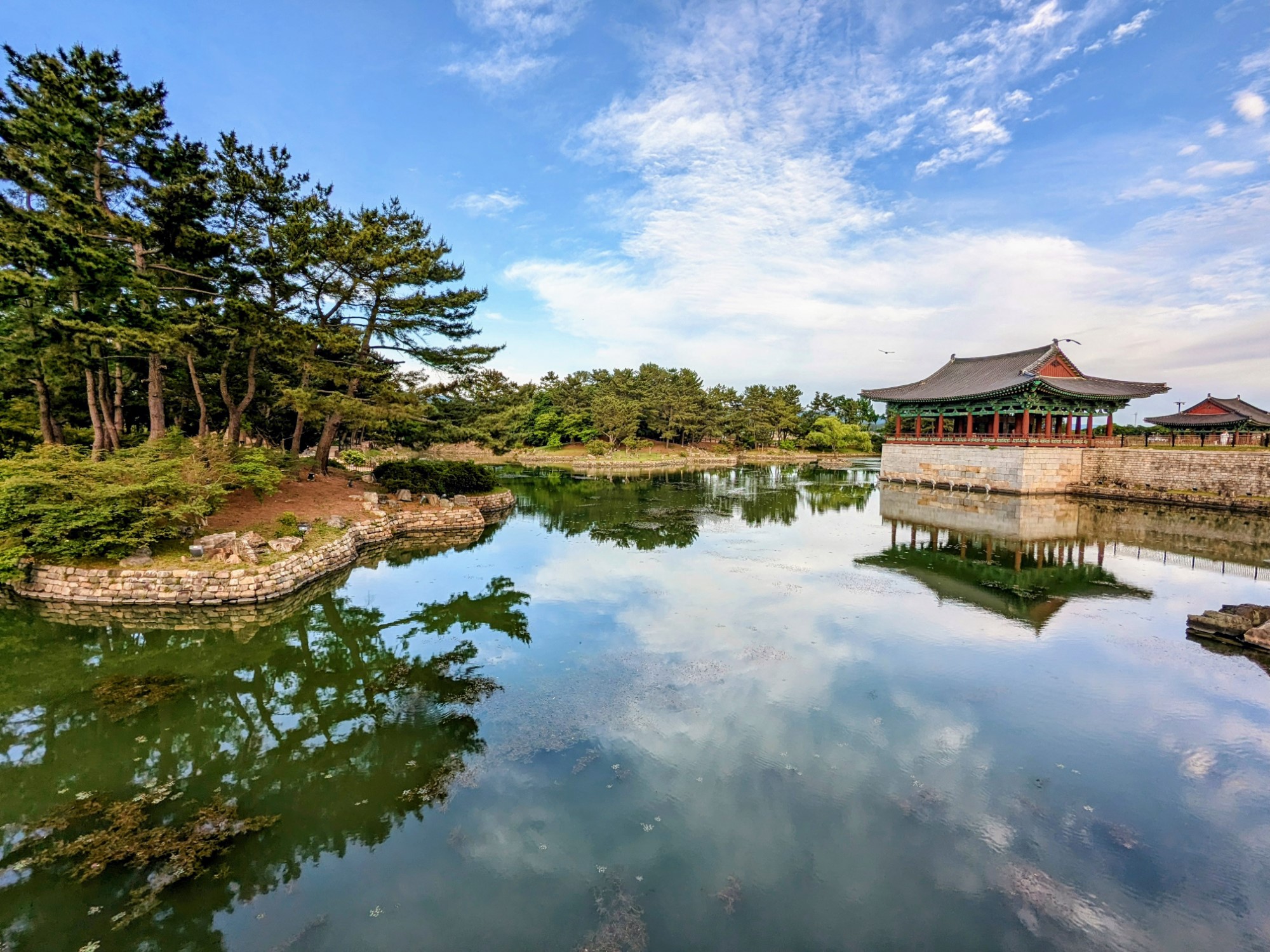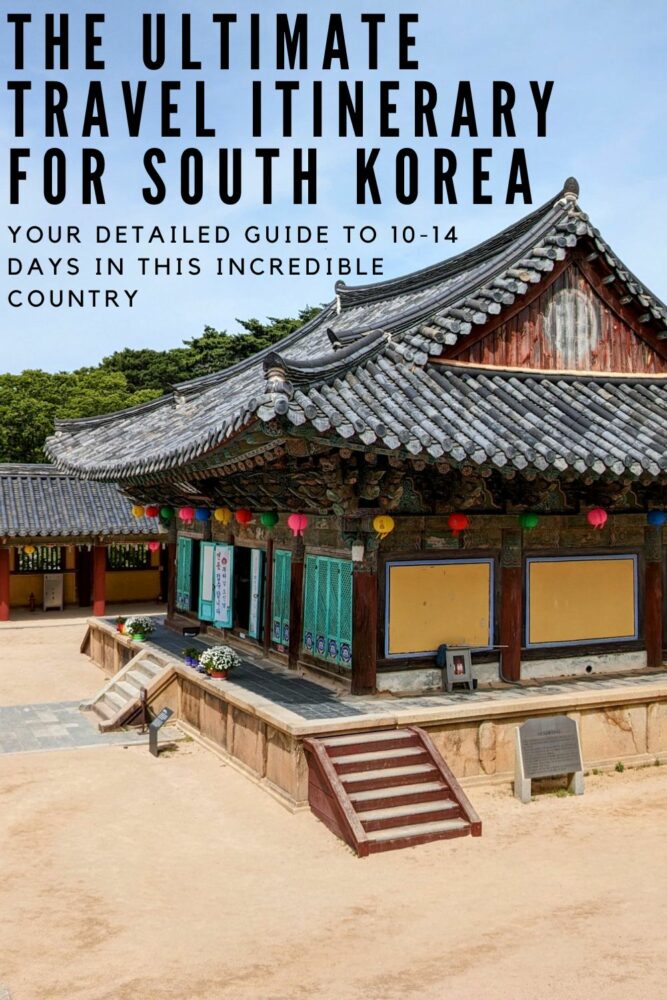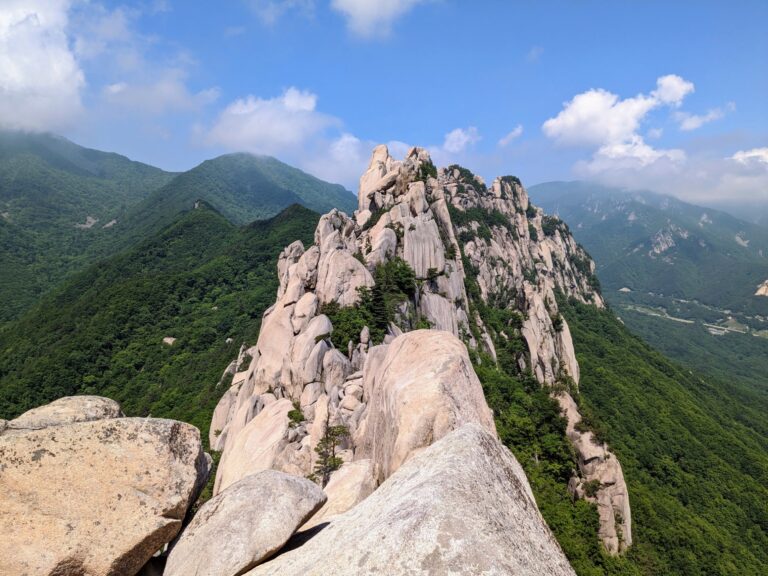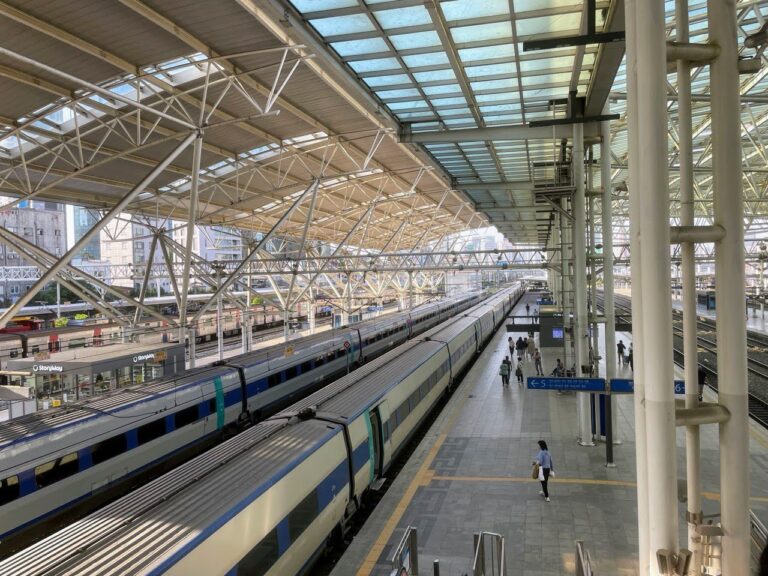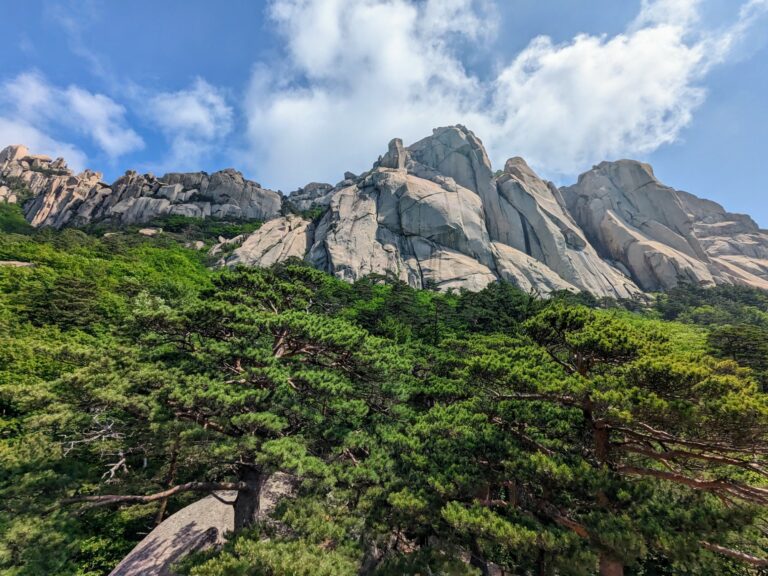The Ultimate 10-Day Itinerary for South Korea
Articles on this site contain affiliate links, meaning I may be compensated if you buy a product or service after clicking them. The full privacy & disclosure policy is here.South Korea is a small and densely-packed country, which makes it a delight to explore. Distances are short, transport links are widespread and reliable, and you never have to go very far for a change of scene. While there’s a lot to see and do, you don’t have to spend weeks traipsing around to make the most of your time there.
In my experience, 10 days is the perfect amount of time to get a real flavour of what South Korea has to offer, from hyperactive cities to pristine natural parks and beautiful historic towns. Whether you’re there for K-Pop or hiking, the incredible food scene or centuries of fascinating history, it’s easily accessible, and this itinerary includes it all.
After flying in, you’ll start your trip proper in delightful Gyeongju, a beautiful and relaxing historic town that ticked so many boxes for what I’d hoped to see in South Korea. From there, you’ll launch head and stomach-first into the bright lights of Seoul, with all of the endless energy that comes with this world-class capital.
Finally, you’ll get to experience a part of the country that I’m convinced will be the highlight of your time in the country. Seoraksan National Park blew me away with its incredible hiking trails, stunning mountains and rivers, and quiet, peaceful surroundings that I honestly didn’t expect to find.
If you have two weeks in South Korea, you could easily add an extra day in and around each of the places I mention if you prefer to move more slowly, or tack on an extra activity or two: I give a few options for that at the end.
Right, let’s get into the detail!
Day 1: Arrive in South Korea
Presuming that you’re arriving at one of South Korea’s international airports, you’re likely to be pretty tired and jetlagged. Rather than throwing yourself into the chaos of a major city, then, I’d recommend heading somewhere much more chill right off the bat. Gyeongju is that place.
Once the political and cultural heart of South Korea, Gyeongju these days is a much more relaxed place to be. This small city in the south of the country is known as the “Museum Without Walls”, and even an hour or two of walking around will clearly show why, with ancient buildings, temples, and burial mounds seemingly around every corner.
Almost all long-haul flights arrive into Incheon Airport in Seoul: if you land early enough in the morning, you’ll have no problem getting to Gyeongju at a reasonable hour. Buses run there directly from the airport, taking about five hours, or you can take the metro from the airport to Seoul Station to catch the high-speed KTX train instead. Total travel time is about the same either way.
Tip: even if you don’t plan to use it straight away to get into the city, be sure to pick up a T-Money card from one of the vending machines at the airport and top it up with a useful amount of money (I spent ₩40,000 following this itinerary). Not only does it make each ride slightly cheaper, it saves a lot of time and effort versus buying individual tickets, especially on crowded buses or at busy metro stations.
If you don’t land until late in the day, just do what I did on my last visit and book a night in a hotel close to Seoul Station, then jump on an early train to Gyeongju the next morning instead. After a long flight, being able to take a shower, sleep, and start refreshed in the morning was very welcome!
We spent the night at a cozy little guesthouse that was perfectly set up for exactly this kind of short stay, less than a five minute walk from Seoul Station. Check-in is open until 10pm: we arrived just after that, and there was a note on the door with our keycode.
The room itself was great for a night: the shower, fridge, and air-con all worked well, and the bed was nice and comfortable. After 11 hours on a plane to get there, it may as well have been the Hilton. Except the Hilton wasn’t in such a useful location, nor did it cost just $65 USD (₩85,000) a night.
When it comes time to take the high-speed train bound for Gyeongju, it leaves Seoul Station from early morning until late evening, and costs around ₩40-50,000 from Seoul. We took the 8:11am departure, and it took almost exactly two hours to get to Singyeongju KTX station outside Gyeongju.
From there, just head out of the station and veer right to find taxis and buses to take you into the city: there’s a picture of the bus stands below. All of the following buses take you into town in about half an hour, and cost ₩1300: 50, 60, 61, 70, 203, 700.
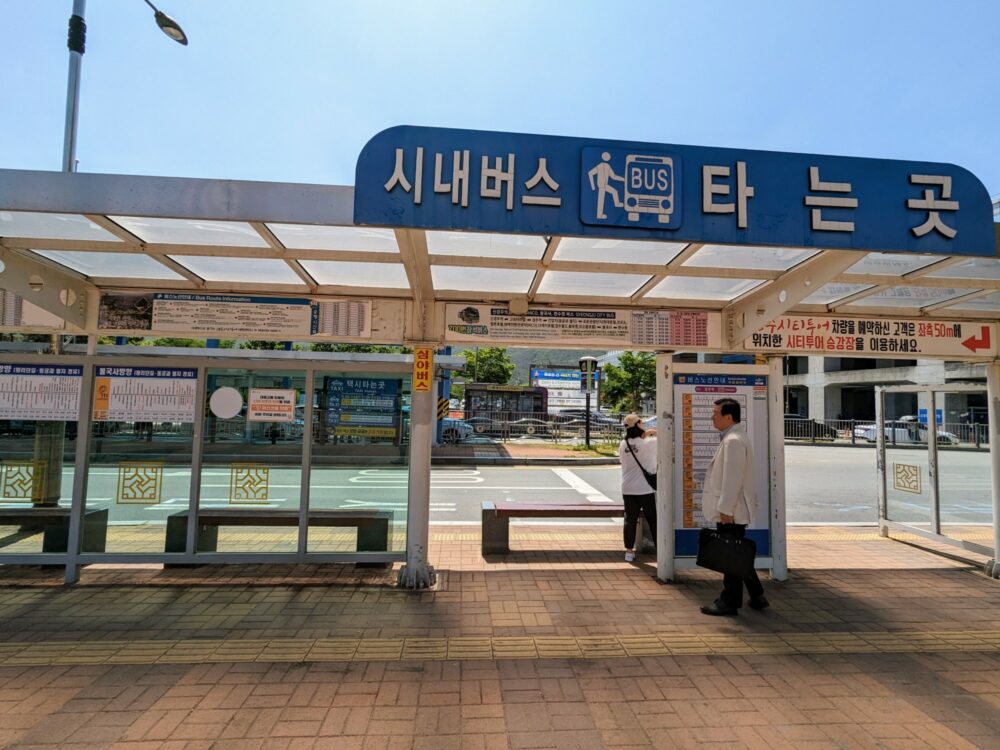
If you picked up a T-Money card in Seoul, you can use it on this bus as well, otherwise you’ll need to pay in cash. The bus runs along the main street through Gyeongju, so just make a note of where your accommodation is so you know where to get off. It’s one of the reasons we chose the hotel we did: there’s a large bridge just before the stop we needed, making for a very obvious landmark!
If you’re anything like me, you’re going to need a little recovery time after a long-haul flight! For that reason, I’ve saved most of the activities for tomorrow: for now, just freshen up, grab some dinner, and get a good night’s sleep in before diving headfirst into things in the morning.
Where to stay in Gyeongju: We loved our time at this cute mini hotel. It was very easy to find, only a couple of minutes from where the bus dropped us off near the Express Bus Station and an easy walk into the centre of town. The manager was super-friendly, and more than happy to look after our bags when we arrived well before check-in time so we could head out exploring straight away.
The room itself was spotlessly clean and quite large for South Korea, and I particularly appreciated the coffee machine in the shared kitchen, complete with little takeaway cups so I could grab one on my way out the door. Paired with the good value (₩55,000/$40 USD a night), I’d absolutely stay here again next time I’m in town.
Day 2: Gorgeous Gyeongju
After breakfast, it’s time to head out and see the city’s biggest attractions: a collection of large lumps in the ground.
These aren’t just any old lumps, though: they’re royal tombs and other earthen burial mounts from the Silla dynasty, which ruled much of the Korean peninsula from the seventh to the ninth centuries. They’re part of the wider UNESCO World Heritage site that covers much of Gyeongju’s historic district, and they’re seriously impressive.
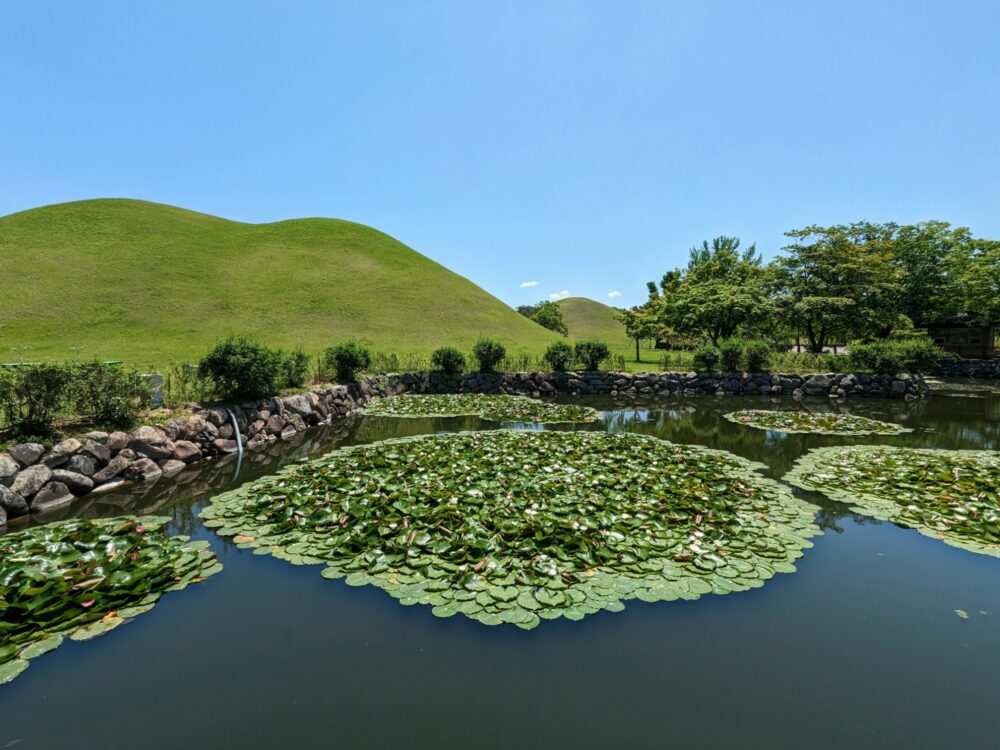
The tombs are in clusters, spread across a series of parks that you can easily walk to and between from any hotel in the city. It’s worth checking them all out, either in one go or just as you explore; they’re really not hard to find!
The most popular area (the Daereungwon complex) is also the largest, with the most tombs. There are several designated photo spots: they’re much quieter early in the morning if you want a shot without dozens of people in. A bunch of nearby cafes and restaurants make it easy to grab a drink or snack before or after your wanderings.
It’s worth visiting the other tomb clusters that lie slightly further north as well; they’re much quieter, and there’s an interesting small museum inside the Geumgwanchong tomb about Silla history and the construction, excavation, and preservation of the tombs that’s definitely worth a visit.
The museum is free, with written and video information in English. I only ended up in there because I happened to be walking past and saw the sign, but I’m very glad I did!
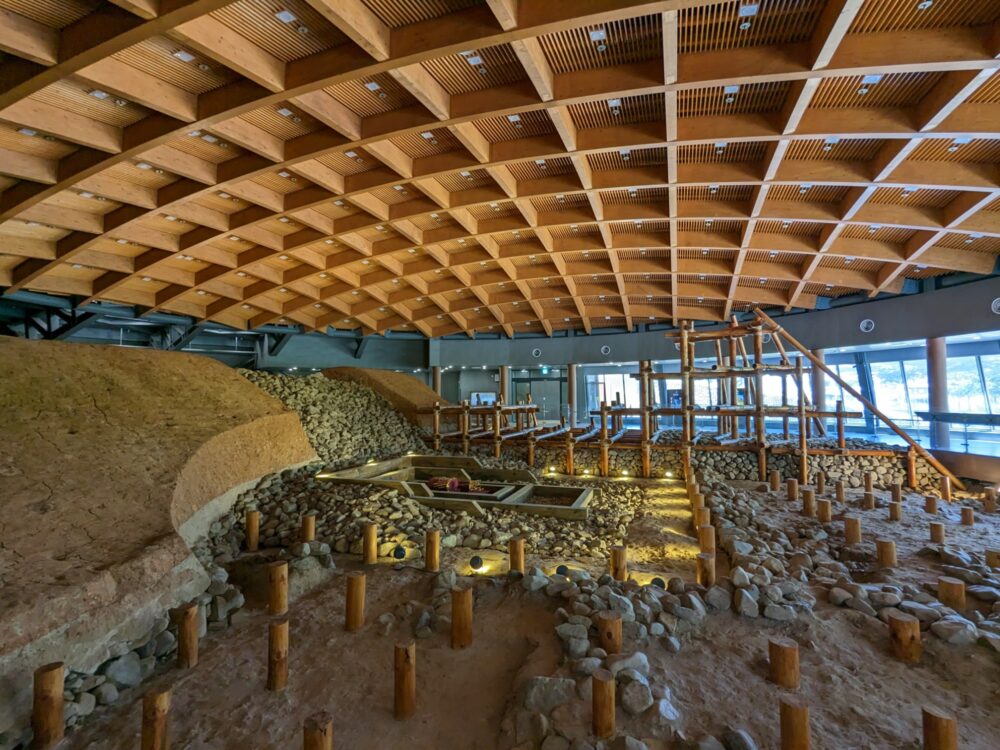
Once you’re done with the tombs, it’s time to go for a stroll down Hwangnidan Road. If you’ve ever seen photos of beautiful wooden hanok-style Korean houses in Gyeongju, chances are this is where they were taken. Most of them have been converted into cafes and shops now, but they’re no less beautiful for it: I ended up walking up and down this street probably a dozen times during my stay, and never tired of it.
Lunch: If you’re feeling peckish by this point, it’s time to stop for bibimbap. If you’re not already familiar with this classic Korean dish, you probably will be by the time you leave the country. Daewha Mandu is a great place to start. The menu at this small restaurant near the start of Hwangnidan Road is simple, and most of the staff speak enough English that you shouldn’t have translation issues!
The tuna-based bibimbap was absolutely delicious, but if it doesn’t appeal, there are a few other options including dumplings and tteokbokki, another tasty Korean staple. Order and pay in advance at the counter.
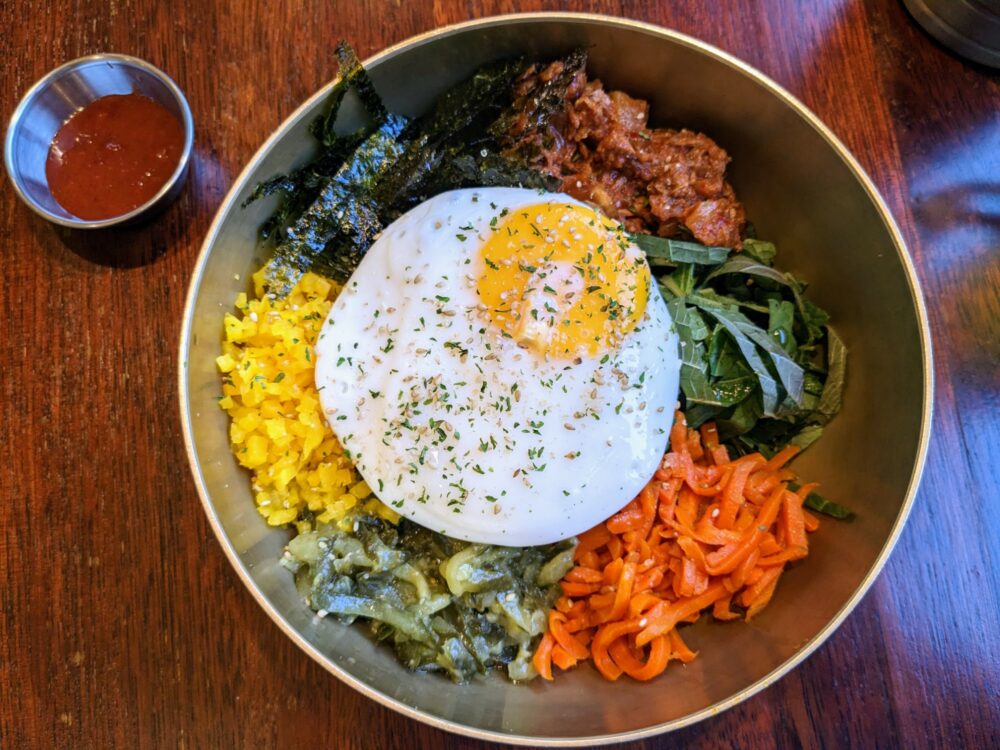
Once you’ve got to the end of Hwangnidan Road, turn left and walk for a few minutes towards the famous Cheomseongdae observatory. Before you get there, though, detour south for a block to Lichoya, an ice-cream store with a different kind of fame.
This place is big on Instagram and Tiktok, thanks to the cute cookies in the shape of Cheomseongdae observatory that come with its desserts. Be sure to order the matcha flavour: it’s what they specialize in, and it’s particularly good!
Ice-cream safely in hand, head back north towards the observatory. Just before you get to the vast park that contains it, though, keep an eye out for a Starbucks that couldn’t be any more Korean if it tried. You’ll see what I mean when you pass it!
The observatory itself dates back to the seventh century, and is the oldest surviving example in Asia or, depending on who you ask, the entire world. You can’t go inside (and not only because the entranceway is at least a dozen feet up the side of the tower), so it doesn’t take long to walk around it.
I was lucky enough to be there in spring, and as interesting as the observatory was, it was hard to focus on it due to the explosion of colour nearby. Fields of flowers lined the walking paths, carved out with convenient photo spots that were in regular use as I wandered past. It was genuinely stunning, so if you’re there at the right time of year, be sure to take advantage.
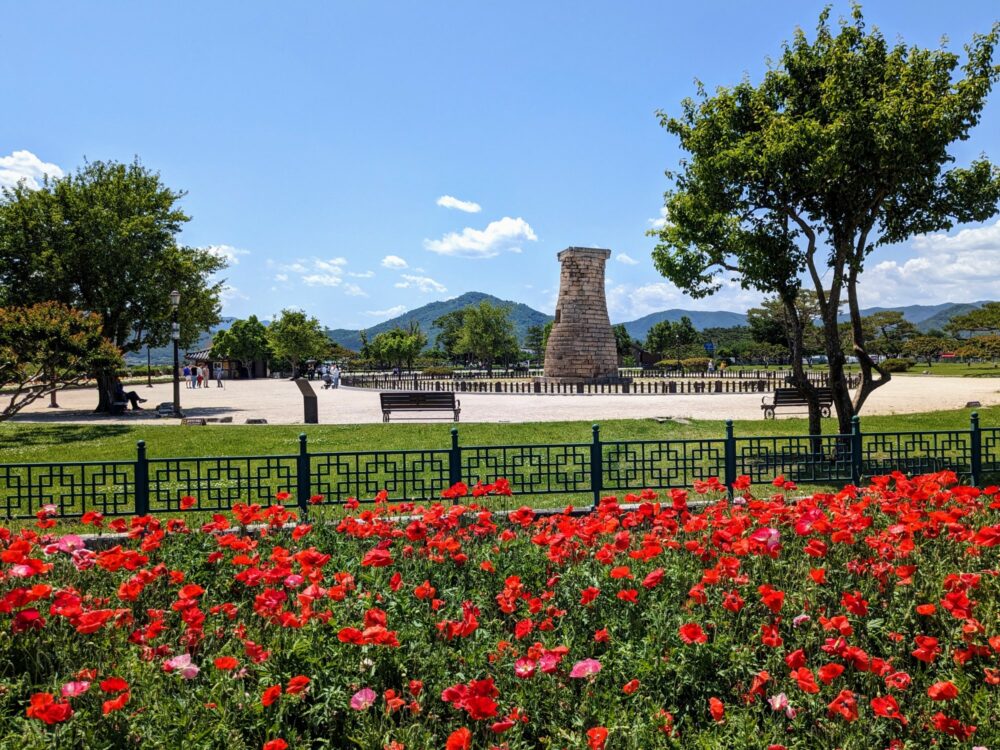
While the observatory is the most well-known historic site in the park, it’s far from the only one. To be honest, it wasn’t even the one I enjoyed the most. For that, keep following the paths south and west towards Woljeong Bridge; you can either skirt around the edge of the woodland or (better idea) wander through it instead. It’s only a small patch of forest, so it’s basically impossible to get lost, and surprisingly tranquil.
Like many of the attractions in Gyeongju, the original version of the bridge dates back to the Silla dynasty. It’s been fully reconstructed since then, and it’s lovely to wander across, take photos, and admire the views up and down the river.
Be sure to head up to the top level as well; there’s a small gallery up there, complete with Korean comic strips about a famous Buddhist monk, and a kiosk where you can take a selfie and edit it to make yourself look like…well, something. A Silla warrior, perhaps, although it’s kinda hard to tell.
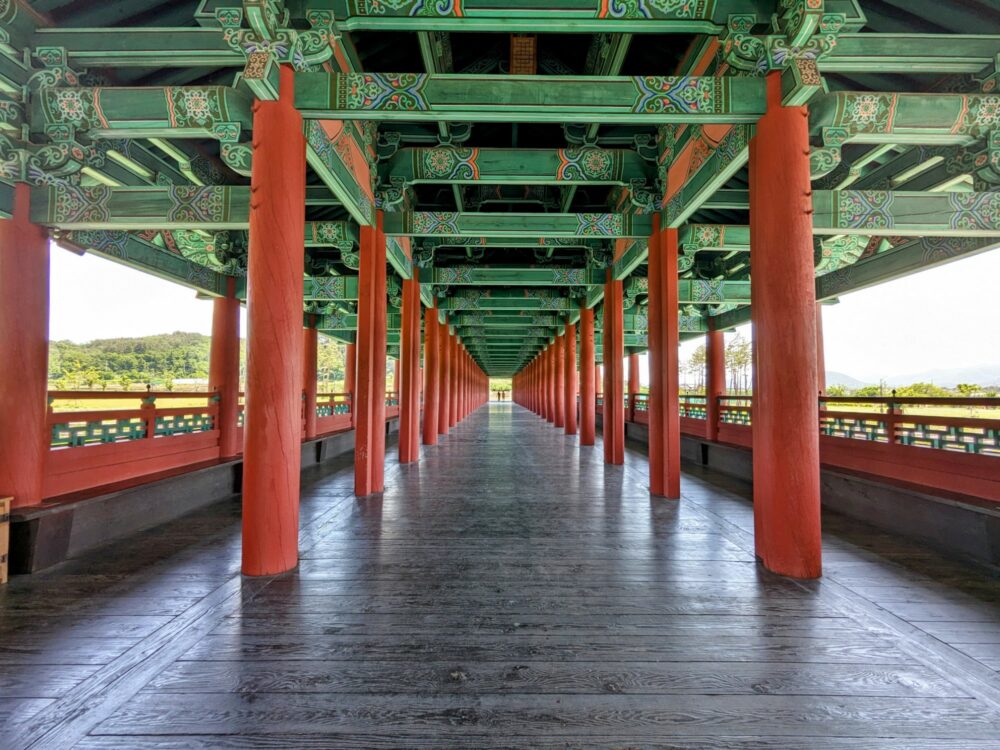
As you were crossing the bridge, you likely noticed a series of stepping stones a little further down the river off to your right. That’s the best way to get back to the other side; it has great views back towards the bridge, and flat rocks where you can stand and take photos while letting other people get past. Just watch your footing if the rocks are wet; they’re not particularly slippery, but you could still fall in if you tried hard enough.
The bridge is lit up at night, so if you happen to be in the area after sunset, it’s worth stopping past again for a different view.
For now, though, you’re very close to the entrance of the Gyochon traditional village. It’s a popular spot, with renovated hanok-style houses that people still live in to this day, and an almost equal number of cafes, restaurants, and places renting hanbok (traditional Korean dress) by the hour for photo opportunities.
It’s a relatively large area, so even if it’s crowded near the main entrance and food area, it’s not hard to find a quieter spot elsewhere. While many of the buildings are private residences, you can go inside a few of them for a better idea of how people used to live. Give yourself plenty of time to wander around here; it’s best explored at a leisurely pace.
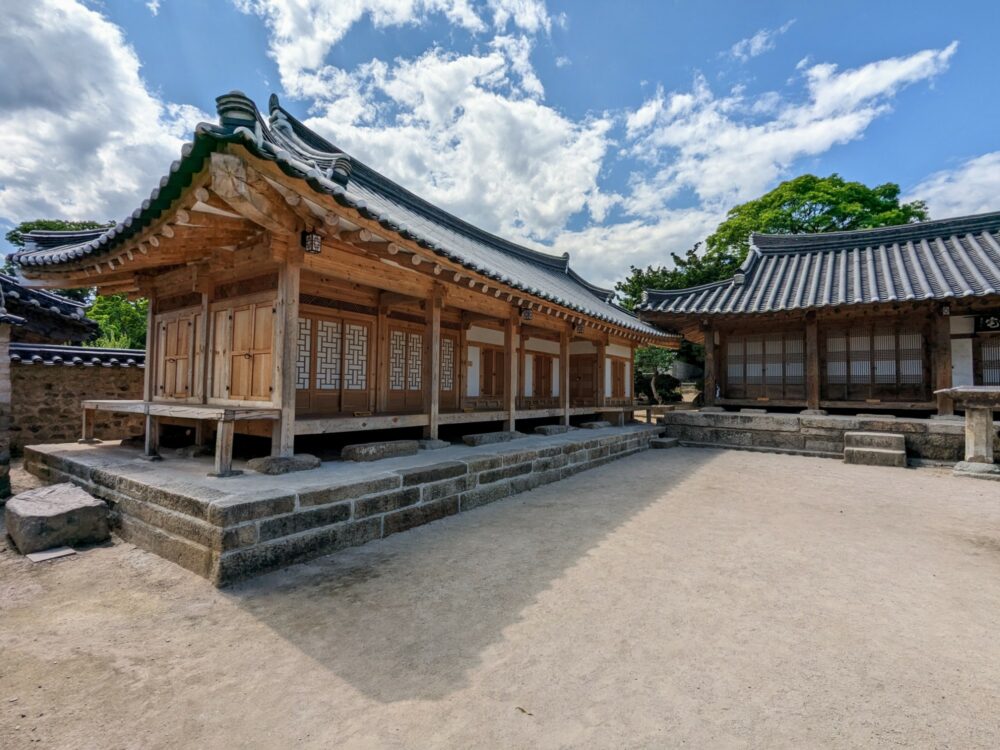
Once you’re done, exit on the eastern side near the woodland you passed by (or through) earlier, and take a stroll back through the park on some of the smaller paths. I really liked this area; if you head towards the Wolseong site, you can walk up a dirt track on (very) small hill just to the north and get a nice overview from the top.
This was once the main royal palace of the Silla rulers, but there’s almost nothing left above ground now. Extensive archaeological work continues to find artefacts at the site, many of which end up in the nearby Gyeongju National Museum. This impressive free museum is devoted entirely to Silla history: if you’ve got the energy to explore today, give yourself at least a couple of hours inside, otherwise walk on past.
Once you’re done, cross the road to another of Gyeongju’s famous attractions, Donggung Palace and Wolji Lake. You may have seen photos of this lit up at night; if the sun is going down by the time you get there, by all means wait around until dark. I think it’s equally lovely during the day, though, and there are far fewer people around. I went in the early evening, an hour or so before sunset, and the light on the buildings and pond was perfect.
The grounds are smaller than you might expect, and as with many historic sites in South Korea, the buildings are replicas of those that once stood here; the originals are long gone. Give yourself an hour or so to walk around the lake. The side closest to town is flat and manicured, while the other side of the lake has a more natural setting, with a dirt trail through the trees and benches to sit and admire the view.
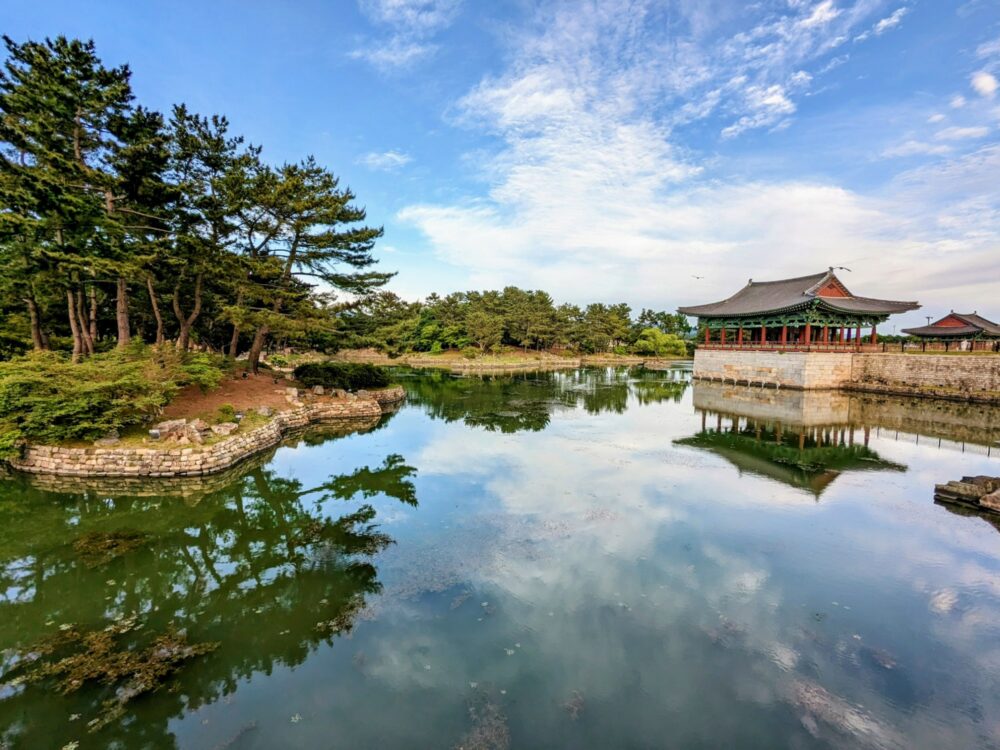
There’s also a small museum near the entrance, which is a good way to kill a bit of time if you’re waiting for sunset. The entrance fee for the grounds is ₩3000 ($2.50) per adult, and last entry is at 9:30pm. Note that there are no pass-outs: if you want to come back later, you’ll need to pay for a second ticket.
And that’s it for the sightseeing today: you’ve definitely earned a drink after all that exploration!
Dinner: head back to Hwangnidan Road for dinner: there, or a few streets either side, is where you’ll find many of the better restaurants in town. I ended up at a Japanese place called Sasiseuseso (사시스세소), mostly because I had an unexpected hankering for spicy soup, and it was surprisingly tasty. You can’t go too far wrong with most of the well-rated places in this area, though; just expect the prices to be slightly higher than some other parts of the country, because it’s popular with both domestic and international tourists.
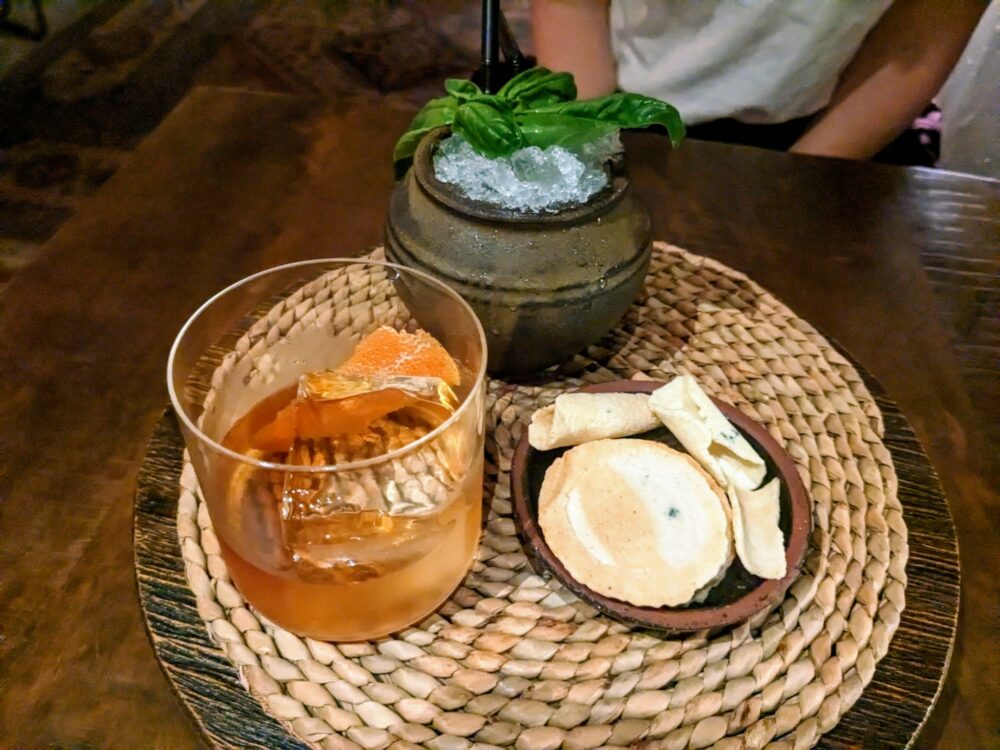
Drinks: if you’re in the mood for those drinks I mentioned, I can highly recommend the cocktails at Bar Boon. They’re not especially cheap, but they’re unusual and very high quality, made with local ingredients by fun, enthusiastic young bartenders who are only too happy to chat. Pull up a stool at the bar, or head upstairs to a lovely cosy area with tables and chairs.
Day 3: Visit Bulguksa and Seokguram Grotto
Today you’re off to Bulguksa Temple and Seokguram Grotto, two famous Buddhist sites that together form another UNESCO World Heritage Site. They’re about 15km (~10 miles) out of town, so you’ll need some kind of transport to get there.
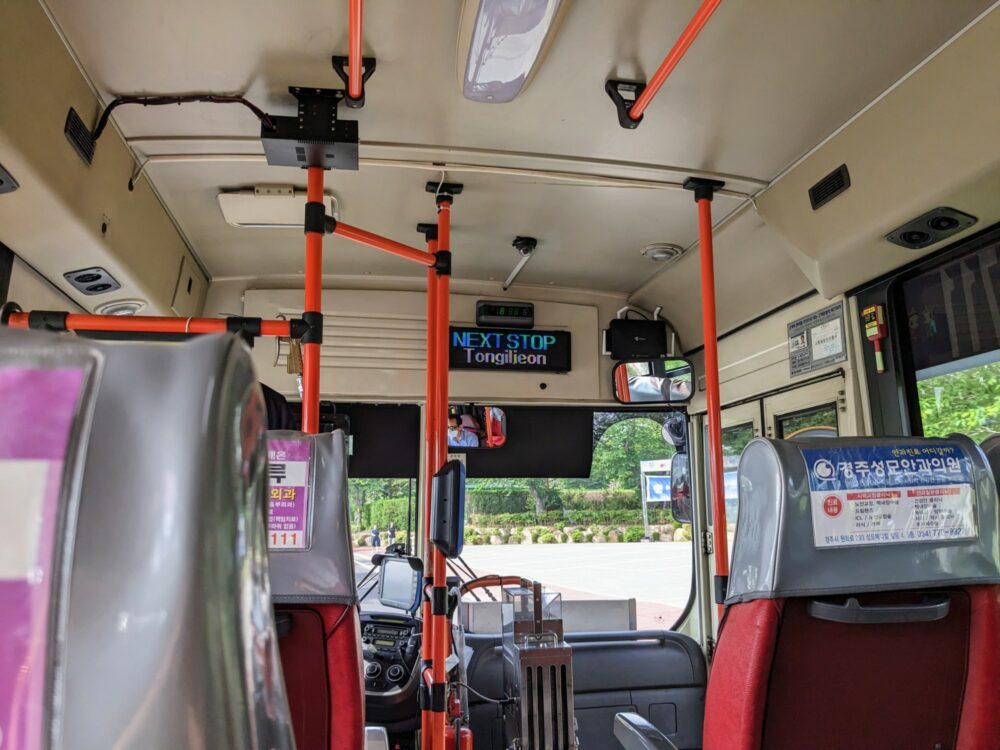
A few different buses run regularly from the Express Bus Terminal, through Gyeongju and out to Bulguksa. Just jump on the number 10, 11, or 700: you can pay with your T-Money card or cash. The buses can be quite busy as they travel through the city, but should be pretty quiet after that.
There’s an announcement and electronic signage in English as you approach Bulguksa, and the bus drops you off on the main road near a cluster of cafes and convenience stores. It’s a good place to get snacks, drinks, and anything else you might want for your time in the park. The entrance is about a five minute walk on a paved path up the hill; there’s plenty of signage around to show you the way.
If you’re pressed for time or don’t feel like dealing with public transport, you can take a taxi to get out there instead. Getting between Bulguksa and Seokguram Grotto and back to Gyeongju shouldn’t be a problem (I saw several taxis waiting in the parking lot at both sites), but your hotel may also be able to arrange for a driver who’s happy to wait.
Bulguksa
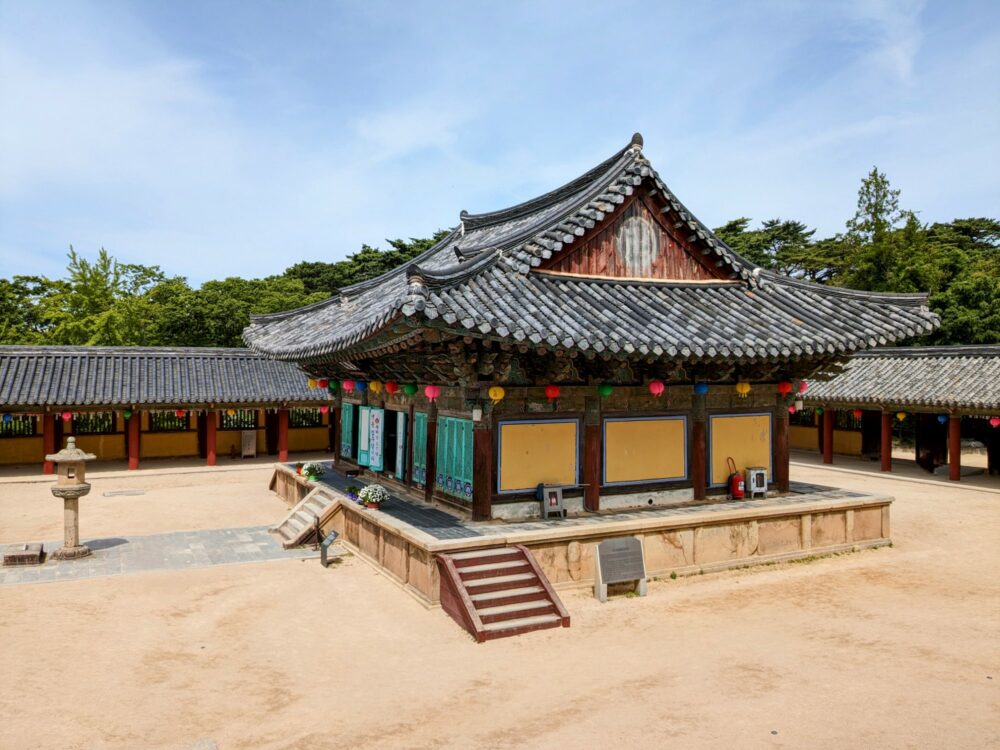
Still a working Buddhist temple, Bulguksa is a major cultural and historic site that dates back mainly to the eighth century, although a small temple is thought to have existed there up to 200 years earlier. All of the buildings in it have been rebuilt after time, fire, and pillaging took their toll, but while they may not be original, they’re far more impressive because of it.
Entrance fees were abolished last year, so although you’ll still see the ticket office to the right of the entrance gate, there’ll be nobody in it. Just walk through the entranceway like everyone else!
Hours vary throughout the year, as below: we arrived just after opening time and had the place largely to ourselves for the first hour or so, but by the time we left in the late morning, the crowds were definitely rolling in. If you don’t mind the early start, get there early to avoid the tour groups, otherwise take a more leisurely approach and just accept a few more people in your photos!
Bulguksa opening hours:
- February: 7:30am to 5:30pm
- March to September: 9:00am to 6pm weekdays, 8:00am to 6pm weekends
- October: 7:00am to 5:30pm
- November to January: 7:30am to 5pm
Before you even get to the buildings, you’ll find yourself in a peaceful natural setting, with a bridge over a small stream and lake that’s surrounded by trees. From there, you just follow the path up the gentle slope towards the main part of the site.
Colourful lanterns decorate several of the buildings and courtyards, and there’s a large collection of stone cairns that have been created by those in search of a little extra good luck over the years. Speaking of good luck, don’t forget to rub the golden pig in front of the Geungnakjeon building while you’re there!
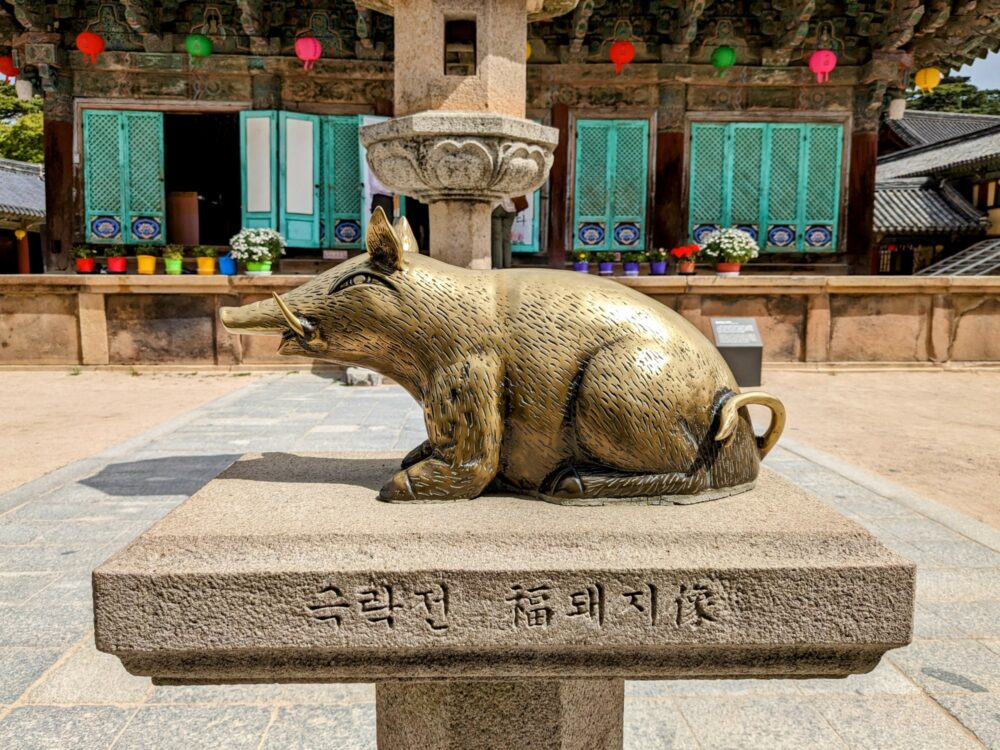
It’s not a huge area, so depending on your interest levels and how fast you walk, give yourself an hour or two to fully explore.
Once you’re done, retrace your steps through the site, taking in anything you missed along the way, until you end up back beside the ticket booths and main carpark. From here, you have a choice: you can either head back down to the main road to pick up some lunch at one of the cafes, or continue on to Seokguram Grotto.
To get between Bulguksa and Seokguram Grotto, take the number 12 bus from either the main road or parking lot. It runs once an hour, departing Bulguksa at forty minutes past the hour, and leaving Seokguram Grotto on the hour. There’s also a walking trail that runs between the two and takes about an hour, but it’s currently closed due to storm damage.
Seokguram Grotto
Part of the same UNESCO site as Bulguksa, but sitting around 3km away as the crow flies, Seokguram Grotto dates from around the same period in the eighth century as the main buildings at Bulguksa. It’s much smaller than the main temple complex, consisting of a stone grotto holding a large carved seated Buddha that’s 3.5m (11.5ft) tall. Several other, smaller religious figures are carved alongside from both Buddhist and Hindu tradition, all behind floor to ceiling glass to protect them from over-enthusiastic humans.
From the carpark where the bus or taxi drops you off, it’s a roughly 500m walk along a gently-sloping gravel path through the forest to the grotto. Before you do that, though, you really should stop at the large bell on the left as you walk from the carpark.
For only ₩1000 (~75c), you get to ring the bell, donating to the upkeep of the site while making a spectacularly loud noise that will get dozens of people to stop what they’re doing, turn around, and look confusedly at you. If that’s not worth the money, I don’t know what is.
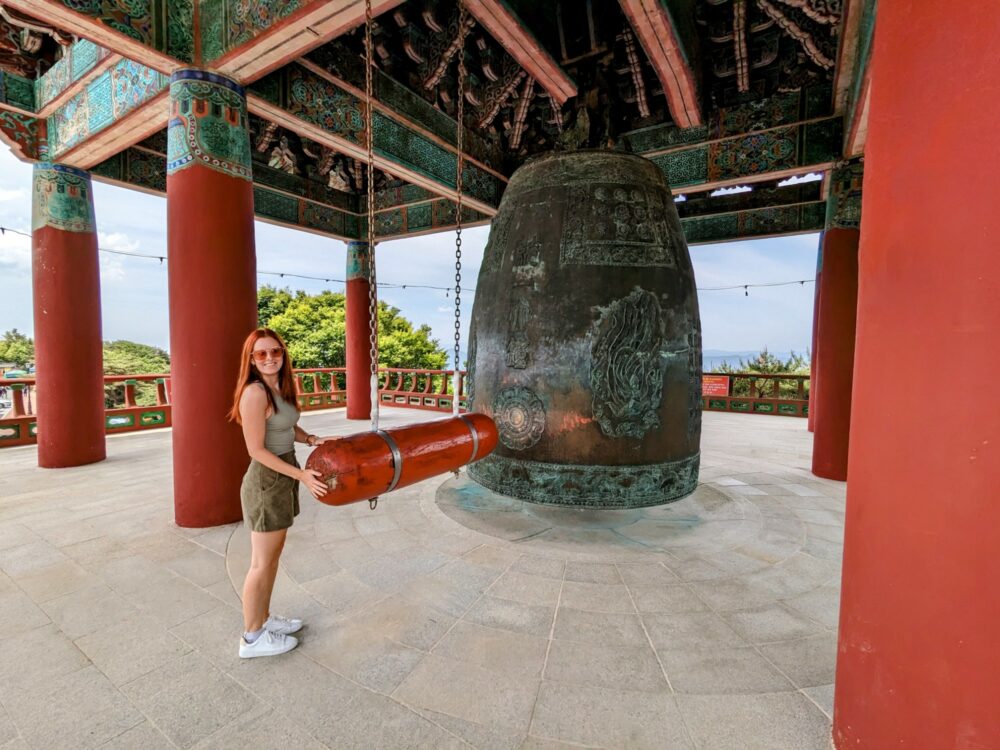
After the ringing in your ears stops, it’s time to head to the grotto. As with Bulguksa, there’s no longer an entrance fee for Seokguram, so just follow the signs towards and down the gravel path. Once you get to the other end, there are a few steps up to the grotto itself: you’re very unlikely to have the place to yourself, but depending on the time of day, the line will either be just a few other people, or…a lot more than that.
The grotto itself is small, with signs outlining expected behaviour. This includes not taking photos inside, so out of respect, I didn’t do that. You’ll likely only get a minute or less in front of the Buddha statue, but there’s nothing stopping you from re-joining the line for another look if you’d like one.
Take some time to admire the views towards the mountains in the distance, before retracing your steps along the path and back to the carpark. You’ll likely spend an hour or so in total at Seokguram, although that does depend on how long the line at the grotto is.
As I mentioned earlier, the bus from here leaves on the hour; when it drops you off at Bulguksa, check the printed timetable at the stop to see how long you’ll need to wait for a second bus back to Bulguksa. You can take a taxi from either site if the wait is too long.
Traditional Meal
Once you’re back in Gyeongju and feeling hungry, it’s time for what may well be the most impressive meal of your time in South Korea. It’s a big call, given how amazing the rest of the food in the country is, but I’m pretty confident about my pick here. It’s the ideal way to try a huge range of local dishes without having to order a lot of anything, and is remarkable value for money.
Hongsi Hanjeongsik is a traditional restaurant that’s well away from the main tourist strip around Hwangnidan Street, but still easily walkable from most parts of town, and only a few blocks from the hotel where we stayed. If it feels like you’re walking through a residential neighborhood to get there, that’s because you are!
It’s open for both lunch and dinner, from 11:30am to 3:30pm, and then again from 5:30pm to 9:30pm. The set menus are the same either way, with two different variations, so just go whenever suits your hunger levels. We didn’t book in advance on a weekday in May, and had no problem getting a table.
There’s a translation on the menu and staff speak good English as well, but this is definitely a more traditional experience than you’ll likely have elsewhere. By that I mean that you’ll be sitting on cushions on the floor at a low table, and that unless you’re already very familiar with traditional Korean food, you’re unlikely to recognize most of the 20+ dishes that show up!
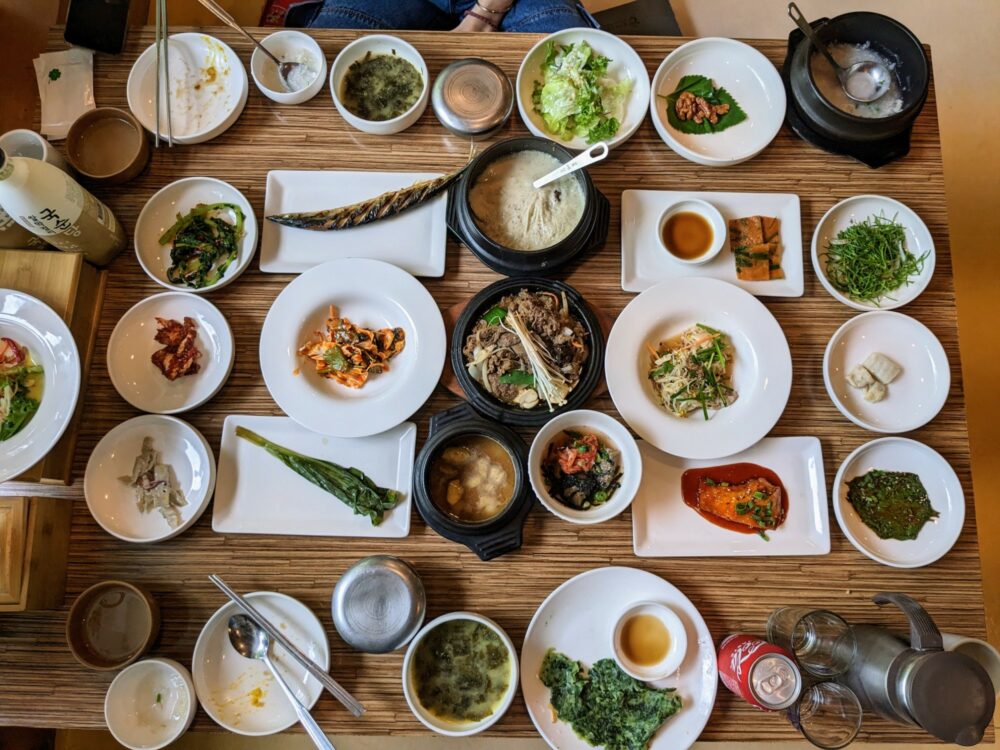
From candied walnuts and pig feet salad to acorn jelly and grilled shark, there was a lot on the menu that I’d never heard of. I didn’t enjoy everything equally, but there was nothing that I genuinely disliked, and plenty that I really loved.
Go in with a sense of adventure and a willingness to try at least a little bit of everything, and I promise you won’t be disappointed by the experience. Washed down with plenty of makgeolli (a delicious milky rice wine that’s one of my favourite alcoholic beverages anywhere in the world), it was definitely a meal to remember, for all the right reasons!
Day 4: Explore Hongdae, Seoul’s Most Vibrant Neighborhood
Check out of your hotel and retrace your steps back to the KTX station at Singyeongju: it’s time to take the train back to Seoul. I’d suggest an early to mid-morning departure, so that you’re left with a full afternoon to explore Hongdae, the most hipster of hipster neighbourhoods in the city.
This is where aspiring K-Pop stars can be found performing on the streets each night, the latest weird fashion trends come and go in the blink of an eye, and the buzz and neon glow of the city never really seems to stop. It also makes for a great base to explore the rest of Seoul, well-connected by metro and bus to anywhere you want to go.
Start your time in Hongdae by dropping your bags at the hotel (we stayed here), then checking out some of the street culture that makes it famous. Street art is everywhere in this part of town, some of it by seriously talented artists. You’ll spot everything from small pieces in tiny alleyways to huge pictures covering the entire side of a building; I found some of the best in the small side streets around Fashion Street, but locations change all the time for obvious reasons, so don’t be afraid to wander.
If you came to Seoul for some retail therapy, you’re in for a treat. Hongdae is one of the homes of shopping in this city, with everything from cute little boutiques to enormous multistorey department stores and pretty much anything you can imagine in between.
Start out at AK Plaza, which is alongside exit 4 of the Hongdae metro station and includes a wide range of well-known brands across its five floors. I spent an hour in here one rainy afternoon, having gone in only looking for a t-shirt and walked out with three of them, having tried on about 15 different things in the MUJI store alone!
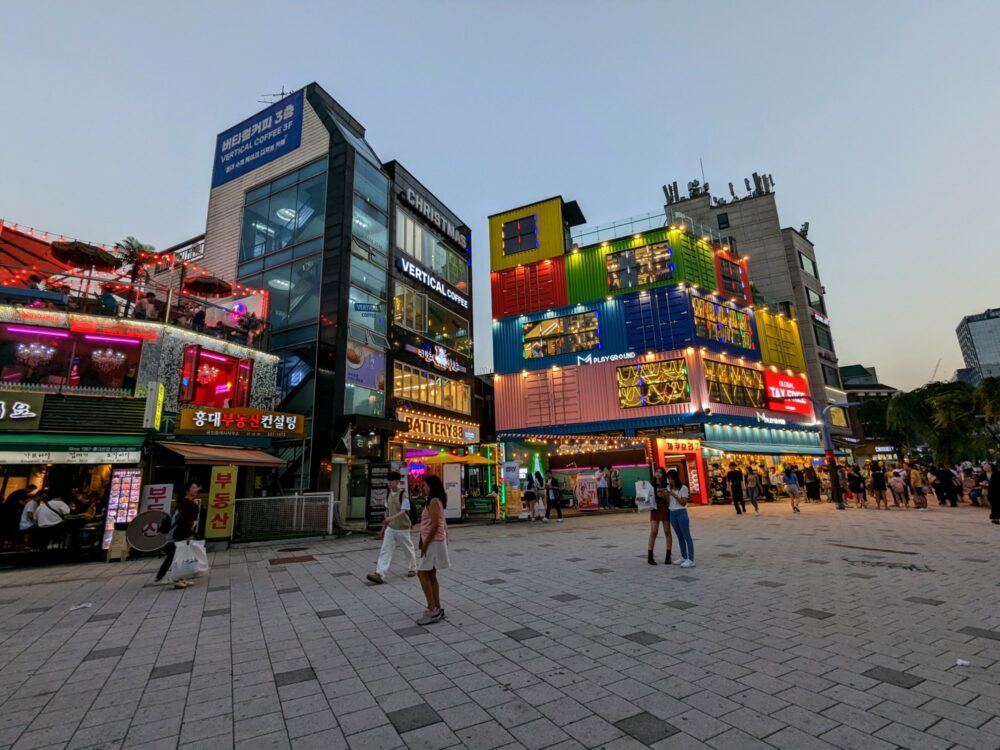
From there, it’s really up to you. Vintage threads, tacky souvenirs, discounted clothing in a store made from (fake) shipping containers, even several floors of fashion eyewear, it’s all in Hongdae, often within a few feet of each other.
Speaking of AK Plaza, it’s the ideal kicking-off point for a stroll along the Gyeongui Line Forest Park. As in many parts of the world, city leaders in Seoul decided to turn a disused railway line into a walking trail. They’ve done a great job, creating a narrow green oasis that stretches for over six km (3.7 miles) northwest to southeast, with AK Plaza roughly a third the way along.
On a nice day, you’ll see plenty of people out walking their dogs, kids, and each other along the paved paths. Keep an eye out for the Gyeongui Line Book Street, a section dedicated to the joy of reading. Sadly many of the little kiosks and book stores didn’t seem to be open any more when I walked past, but the public artwork is still there regardless.
There are endless options for cafes and restaurants along pretty much the entire length, so walk for as far as you feel like, then branch off a block or two in either direction for some refreshment.
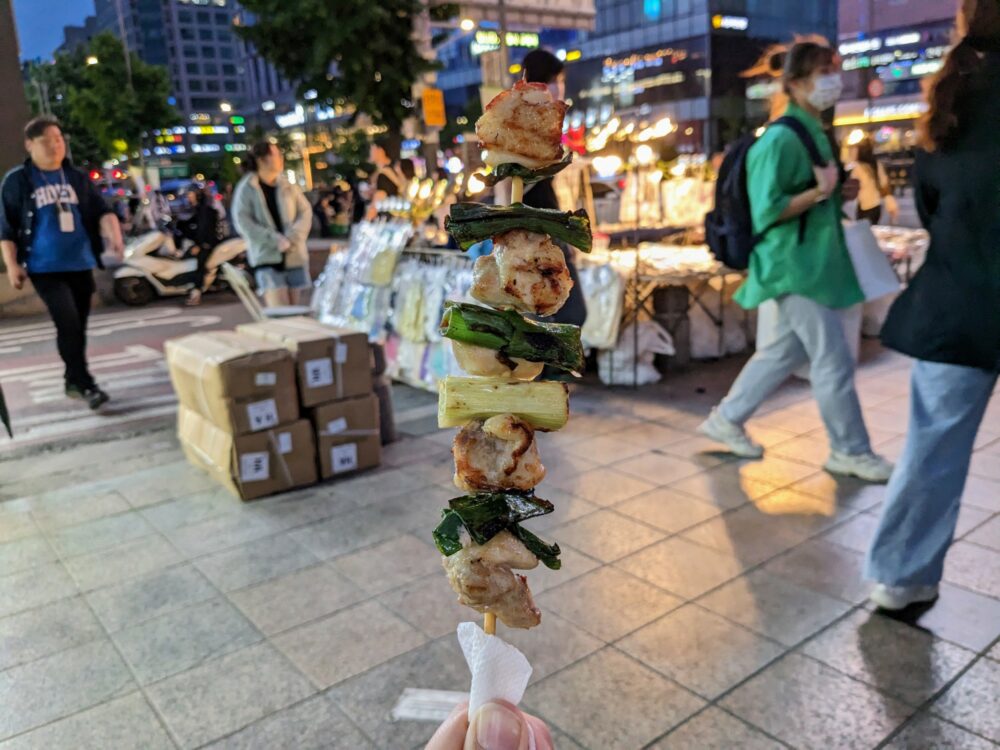
Once night falls, the already-bustling streets come even more alive. Night markets pop up, some stretching for multiple blocks, with food trucks and unidentifiable objects for sale in equal measure. Make sure you’re wandering around on Hongdae Street at this time; in some sections of this long, semi-pedestrianized thoroughfare, you literally can’t walk a block without coming across a new group of street performers performing choreographed dance moves to an ever-changing crowd.
Chicken and beer is a huge thing in Korea, so much so that there are entire streets dedicated to it. You’ll find several chicken and beer restaurants basically alongside each other on Hongdae Street, packed with patrons from late afternoon onward. They’re all pretty good, but I preferred the crispy, spicy drumsticks at Kyochon Chicken, a couple of blocks back from Hongdae Street and just off the main Yanghwa Road. They were so delicious, I went there twice!
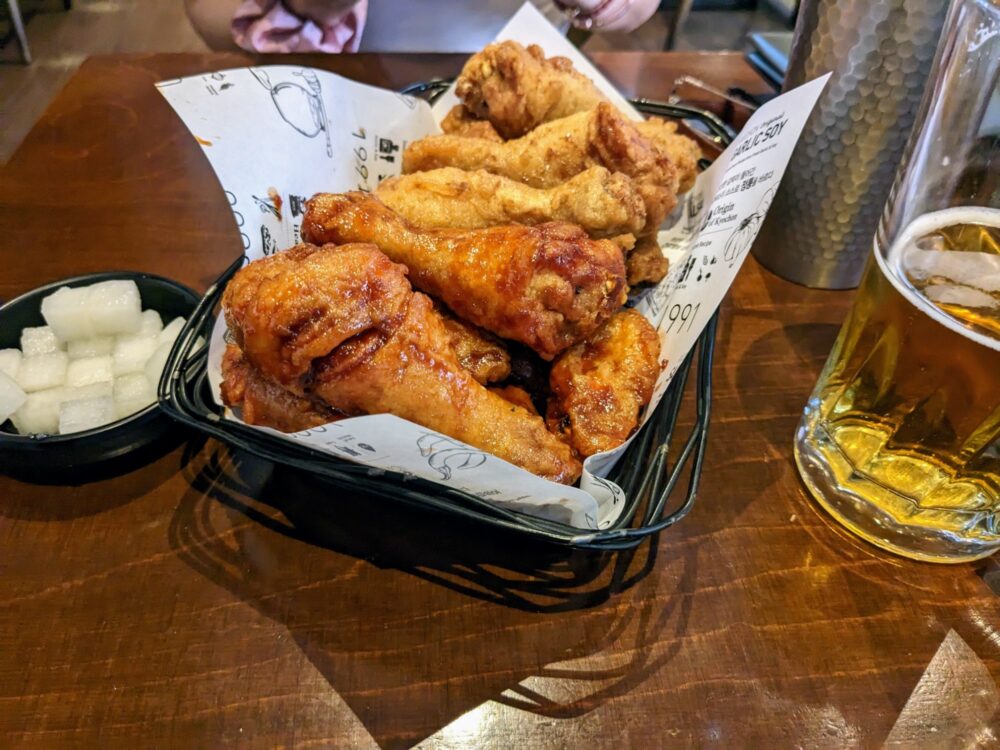
Speaking of beer, while the mass-market Terra and Cass are perfectly drinkable and pair well with sunny days and/or fried chicken, there’s a growing craft beer scene in and around Hongdae as well. Head to Brew Heim, Craft One, or Deeper to sample some of the best local and international options.
Once you’ve downed a sufficient number of those craft beers, it’s time for karaoke. This is serious business in Korea, with several 24/7 multistorey buildings devoted entirely to it on Hongdae Street alone. Just look for the signs and head inside: you’ll get your own soundproof booth, with a vast array of English songs available, plus Korean and often Japanese hits as well. You pay by the hour, with a minimum spend on food/drink as well.
After you’ve eaten, drunk, and sung your heart out, finish the night at Zzang Games. This huge arcade has pretty much everything, from dance mats and shooting games to driving simulators and a wide range of those endlessly-frustrating machines where you try to grab soft toys and other prizes using a mechanical claw. Entry is free, you just pay for each game you play.
Where to stay in Hongdae: We splurged a bit for our time in Hongdae, and this stunning hotel couldn’t have been more worth the money. It really is one of the best places to stay in the city, and considering that, is pretty good value. Our modern, stylish room had amazing views, which were bettered only by those from the rooftop bar; whether you drink there or not, you definitely have to go up to take photos at sunset!
We even got a free bottle of wine, a local travel-sized game to play and keep, and a pack of fancy toiletries. Despite being right in the heart of this bustling neighbourhood, the sound insulation was so good that I couldn’t hear any outside noise at all.
The hotel gym was larger and much better equipped than almost any other I’ve used, and while the in-room coffee was very good, the brews from the downstairs café were even better! I’d stay here again in a heartbeat.
Day 5: Historic Seoul
If yesterday was all about modern-day Korea, today focuses firmly on the country’s past. Despite being such a trend-setting city in many ways, Seoul’s links with its history are never far from the surface.
There are five famous royal palaces, for instance, all conveniently located quite close to each other. Unless you have a lot of stamina, though, I’d suggest not trying to visit them all in a single day: it’s a lot of walking, and there’s a good chance you won’t appreciate much of what you’re seeing by the end of the day!
Instead, I’ve selected the three must-visit palaces, leaving the other two as options if you have extra time or want to skip out on some of the other activities I mention in Seoul. This gives more time to explore each one, as well as take in all of the other things to do nearby without being too tired to enjoy them.
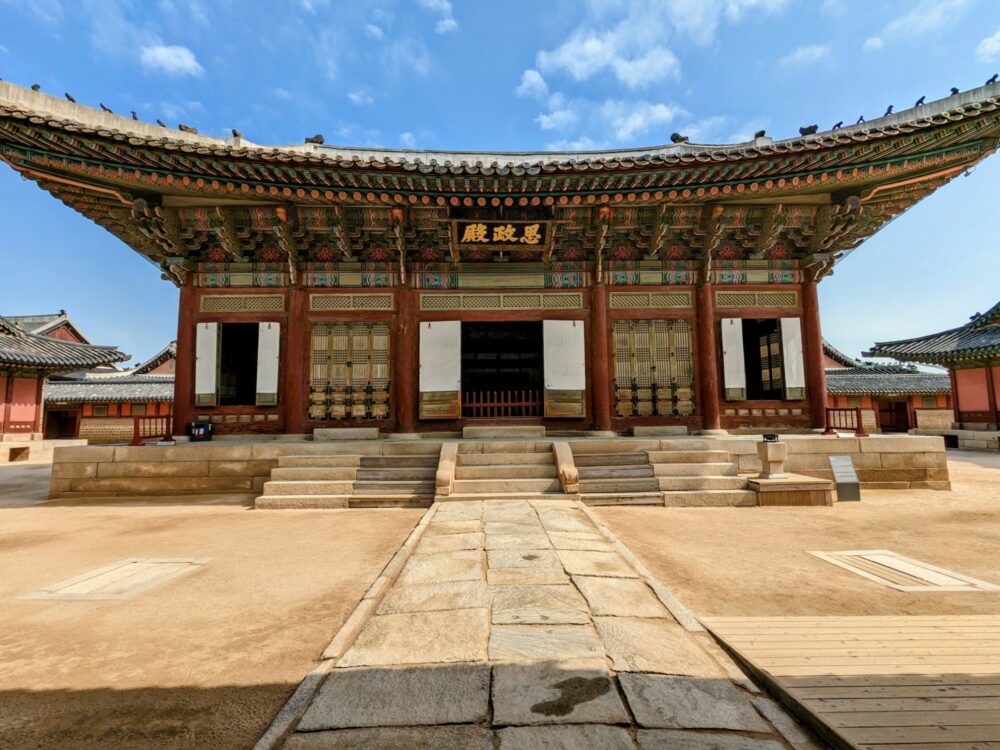
Let’s start with Gyeongbokgung Palace. It’s the biggest and most impressive of the five, first built in 1395 and stretching over an impressive 100 acres (nearly 4.5 million square feet)! To get there, take the metro to either Gyeongbokgung Palace station (exit 5) or Gwanghwamun station, exit 2. Once you emerge at street level, it’s impossible to miss. Do note, however, that it’s closed on Tuesdays.
You can either pay for an individual entry ticket (₩3000), or buy a pass that gives access to all five palaces for ₩10,000. It’s valid for three months, and assuming you’re planning to go to Changdeokgung palace (below), will save you money. Anybody wearing hanbok gets in to all of the palaces for free: it’s a popular pastime, and there are dozens of nearby shops renting this traditional Korean attire by the hour or day if that’s something you’d like to do.
A ceremonial changing of the guards takes place at 10:00am and 2:00pm each day; I’ve been to many of these around the world over the years, and this is one of the most impressive. Because of that, it definitely attracts the crowds, who tend to arrive just before the ceremony and then spend the next hour or two exploring the site.
For that reason, I’d recommend arriving around opening time at 9:00am and heading straight for the gardens and pond at the rear of the complex, so you can enjoy the peaceful surroundings without hundreds of other people around. Once you’re done there, just work your way back towards the main gate, being sure to arrive at least 15 minutes before the parade starts so you can get a good spot along the roped-off area.
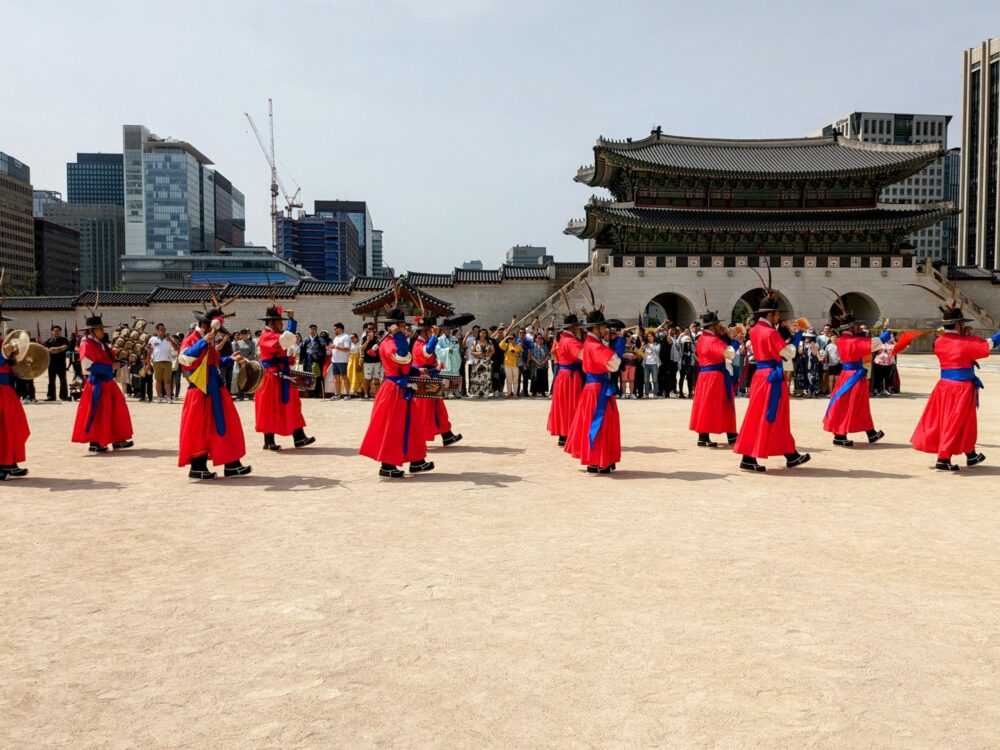
Like so many of the historic sites in Korea, nothing remains of the original buildings. They were burned to the ground during the Japanese invasions in the 1590s, and after being rebuilt in the nineteenth century, were then systematically destroyed by the colonial government during the Japanese occupation in the early 1900s. Only ten buildings survived that destruction, with everything else being rebuilt since 1989. They’re still stunning, of course; they’re just not original!
Once you’ve taken in the changing of the guard, which takes about 15 minutes, finish up looking around the front section of the palace and then head out the main gate. It’s time for some more delicious food!
Lunch: if you’re looking for an unusual place to eat with few other foreigners, head to Tosokchon Samgyetang. It’s only a short walk from Gyeongbokgung Palace, and has been serving up its famous ginseng chicken soup for the last several decades.
It’s a popular spot, which is why we skipped breakfast that day and got there around 10:30am for an early lunch instead. The restaurant opens at 10am, and lines start forming outside soon afterward. We went for the black chicken, which looks unusual but doesn’t affect the taste, along with a seafood and scallion (green onion) pancake and the obligatory sides of kimchi and pickled garlic.
The chicken was super-sort, falling off the bone, and the broth was delicate and delicious. There’s even a useful guide (in English) on how to tackle the meal correctly, which we definitely appreciated: we’d have had no idea otherwise! It cost a total of ₩47,000 for two ($35 USD): not the cheapest meal we had in South Korea, but absolutely worth it for the experience.
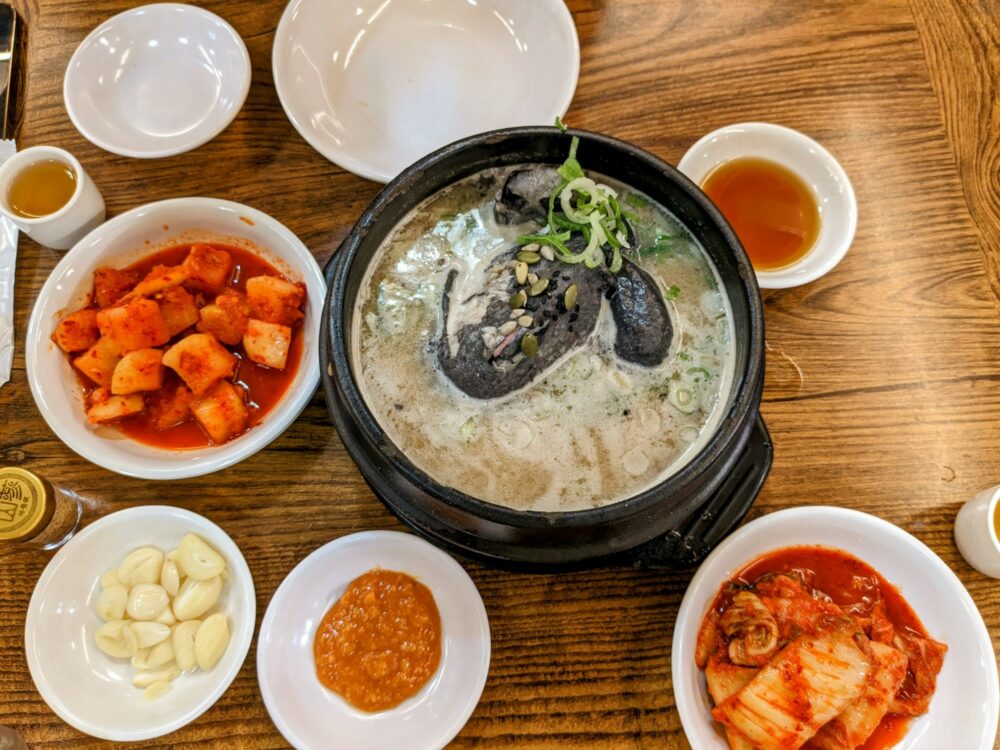
Once you’re done, it’s time to work off some of that tasty soup with a bit of a walk. Your next stop is Bukchon Hanok Village, a spot that’s become Insta-famous in recent years for its beautifully aesthetic restored houses that date back to the Joseon era, wedged tightly together on the side of a small hill. It’s about a half-hour walk away, on the other side of Gyeongbokgung Palace.
As with most great views the world over, there’s a bit of effort required to get them. In this case, it’s a fairly steep climb up the village streets to the top of the hill, so you can get those long, lovely views back down the narrow alleyways. The famous photo spot is helpfully marked on Google Maps.
You don’t need to spend a lot of time here; because people still live in most of these houses, there’s not a lot to see beyond the elaborate facades. That said, it is worth having a look around beyond that singular photo spot: things get much quieter only a short distance away, and the buildings are just as pretty.
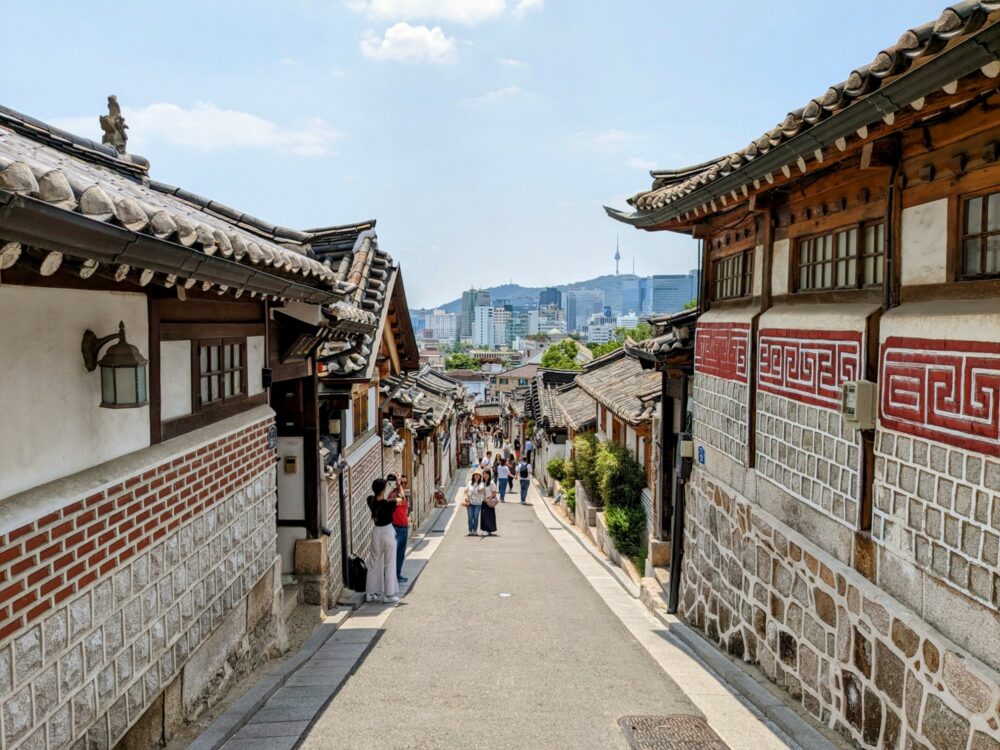
Moving on, it’s time for Changdeokgung Palace: the entrance is about a 15 minute walk from Bukchon village. If it’s a hot day and you’re in need of refreshment, stop off at Onion along the way: this popular café is famous for its cakes and other baked goods, although I had no idea of that when I popped in for a coffee and wondered why the line was so long! It moved quickly, though, and it’s such a lovely building that I didn’t mind the wait.
The palace itself is large and reasonably interesting, but for most people, it’s the Secret Garden inside that they’ve really come to see. Entry to the garden is only permitted as part of a guided tour, which is offered in Korean, English, and Japanese.
Tickets cost ₩3000 for the palace and a further ₩5000 for the secret garden: both are included in the palace multi-pass I mentioned earlier, but you do need to exchange the voucher in the booklet for a timed ticket on a guided tour. The palace and garden are closed on Mondays.
The English tours run at 10:30am, 11:30am, 2:30pm, and (other than Jan/Feb), 3:30pm, and take about 90 minutes. With that in mind, I’d suggest booking yourself on the 2:30pm tour, so you don’t have to rush to get there and have plenty of time to explore the palace grounds beforehand. There are 100 places available on each tour, with half able to be booked online up to six days in advance, and the others available on a walk-up basis.
If you didn’t manage to get yourself one of the prebooked slots, I’d suggest arriving at the palace by 1:15pm. That way, you can go straight to the ticket office for the secret garden, book yourself on the next available tour, and then explore the rest of the grounds while you wait.
The gardens themselves are quiet and peaceful, a lovely little slice of nature in the middle of a metropolis. Much of the area is quite manicured, with ponds and small buildings, but the final 15 minutes or so of the tour goes through a more natural, wooded area. This is also the steepest part of the track, although that’s really only by comparison with the dead-flat path that precedes it.
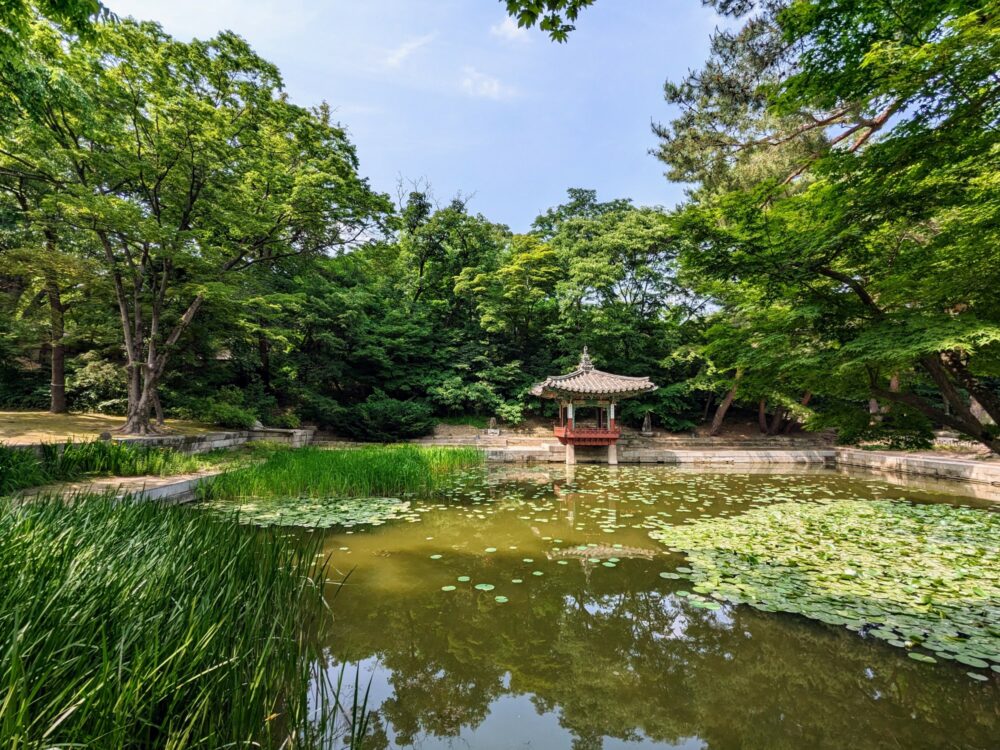
You finish the tour back close to where you started: once you’ve seen everything else of interest in the palace, it’s time for the final attraction of the day: Changgyeonggung Palace. Far less-visited than the previous two palaces, it has a much more natural, woodland feel, with several lakes and reservoirs, and trails that branch off in various directions.
Conveniently, you can access it via a small gate at the back of Changdeokgung Palace, so you don’t need to go all the way back out and around to the main entrance. It’s the cheapest palace to enter, at just ₩1000 (again, entry is included with the multi-pass), and is also closed on Mondays.
There’s a particularly photogenic spot inside this palace, one that we just happened to stumble upon as we walked past. Stone steps lead down to a large courtyard that was once a residential area for the queen and concubines, which are flanked by large trees. With the contrast of the city’s skyscrapers clearly visible in the distance, it’s one of my favourite photos from my entire time in Seoul.
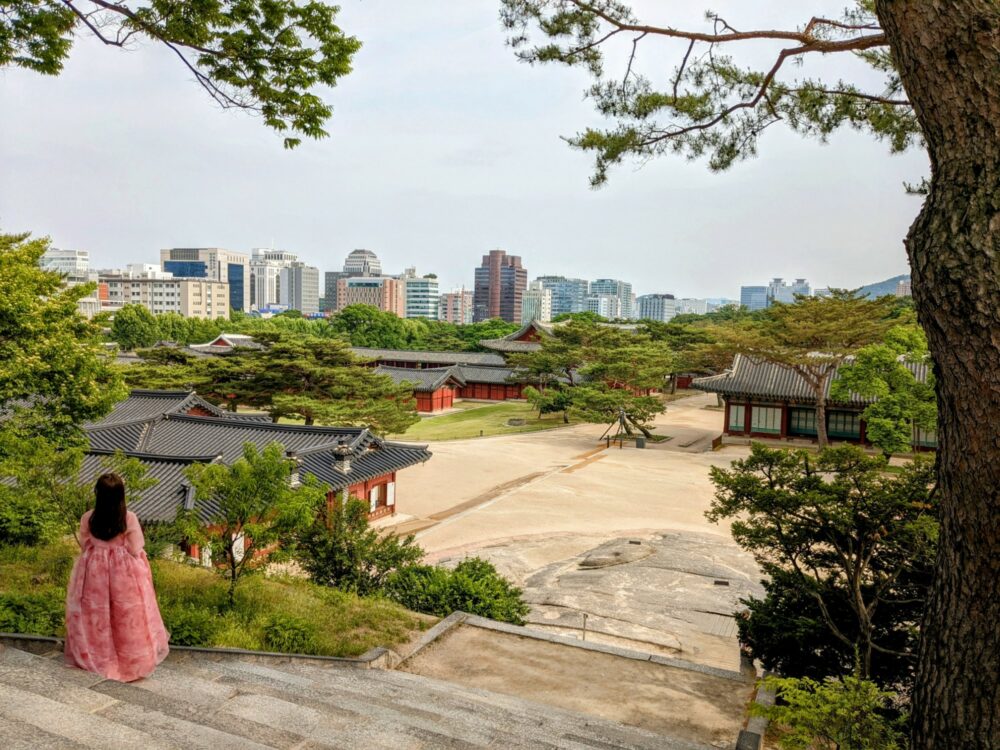
We chose to explore the palace grounds at a leisurely pace, taking about an hour to work our way around and ultimately out to the main entrance/exit gate on Changgyeonggung Road. From there, the number 7101 bus runs regularly back to Hongdae and takes about 45 minutes: it’s faster and easier than walking back to a metro station.
Got a Second?
I pay for all my travels myself, don’t work with tourism boards or PR people, and don’t accept freebies or discounts. Everything in this post is based on my own experiences, and every word is written by me. I’d rather go lie down in a ditch than use AI.
Because of that, I rely on my readers to help keep me on the road. Everything I write will always be free to read, but if this post helped you plan your trip, I’d love it if you’d consider making a small donation so I can keep doing this in the future. If you’re able to help out, thanks so much in advance!
Day 6: Cultural Seoul (and Market Madness)
Today, you’re off to Insadong, which is Seoul’s cultural heart and easily one of my favourite neighborhoods in the city. I was surprised how much I loved it here: it’s the perfect place to go shopping for one-off souvenirs that you won’t find anywhere else, eat in little family-run restaurants, and just wander around getting lost in the cobbled alleyways that snake off the main street.
It’s not just about art and tradition, though: tucked between antique stores and tiny boutiques selling beautiful stationary, you’re just as likely to find a hipster coffee shop as an art gallery. This area is ideal for exploring on rainy days; I kept getting caught in showers during the day I spent here, which just gave the perfect excuse to duck inside a shop or spend a bit longer sipping that coffee!
The neighbourhood itself is close to where you were yesterday, a little south of Gyeongbokgung and Changdeokgung palaces. Aim for Jonggak station on the metro to start your day, making sure to check out the small “solar” garden inside the station before heading out onto the street.
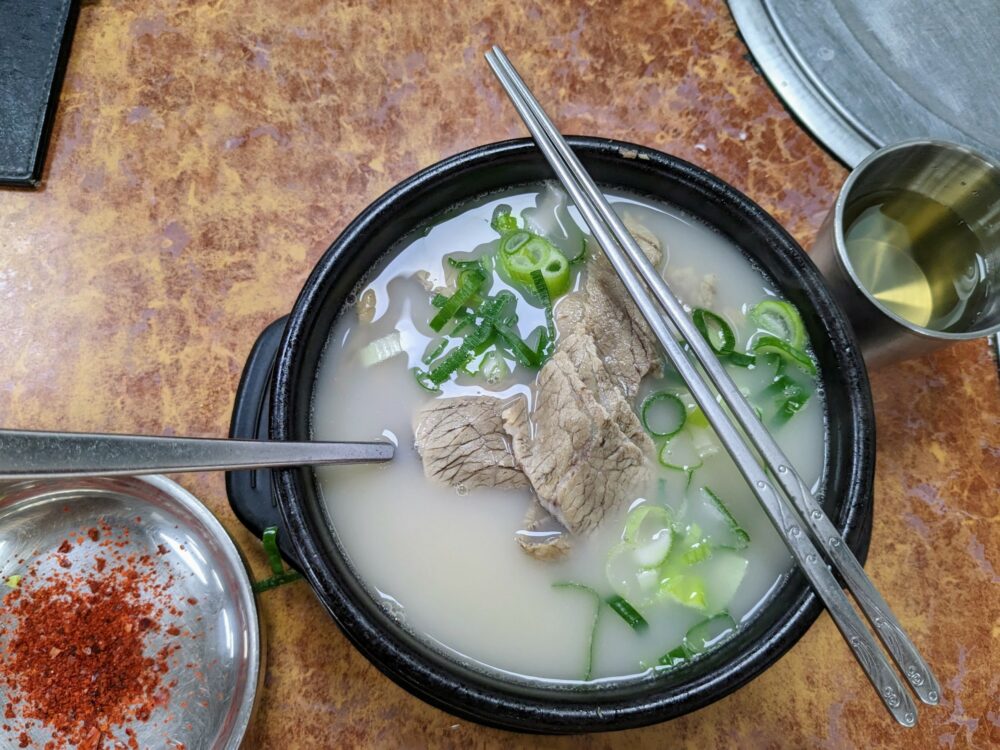
Like the day before, we decided to forgo breakfast in favour of an early lunch, this time at Imun Seolnongtang. Famous for the ox-bone soup that they’ve been turning out for over a century (so much so that they got a mention in the Michelin guide), the place is slightly tricky to find and resembles a school canteen on the inside. It really is all about the food.
There are only three options on the menu, so it’s not hard to figure out what to order even though there’s not a lot of English spoken. If you go for the soup (and you should), don’t be afraid to be heavy-handed with the sides: the broth is quite bland by itself, with the idea that you mix and match to exactly your preferred flavour. We paid ₩13,000 each for our soups.
Once you’re done, the best way to experience Insadong really is just to wander without a lot of intention, both along the main street that’s lined with galleries and boutiques, and the numerous alleyways that spider off from it. I’d recommend taking a near-empty backpack with you; there’s a good chance it’ll be full by the time you leave! We filled ours with lovely ceramic mugs, both as gifts and to keep as souvenirs: I’m sipping my morning coffee from one as I write this.
One place that’s particularly worth going, though, is Ssamzie-gil, a four-storey open air shopping mall that’s crammed full of wonderful little stores that mostly seem to sell one specific type of item. You can (and we did) lose plenty of time inside here; we walked away with various unusual earrings, pens, and other random souvenirs that we hadn’t seen anywhere else, and could have bought a lot more!
When you’ve worked up an appetite from all that shopping, it’s time to head towards Gwangjang market, made famous in the west thanks to Cho Yonsoon’s starring role as the “knife-cut noodle lady” in the Seoul edition of Netflix’s Street Foods: Asia series.
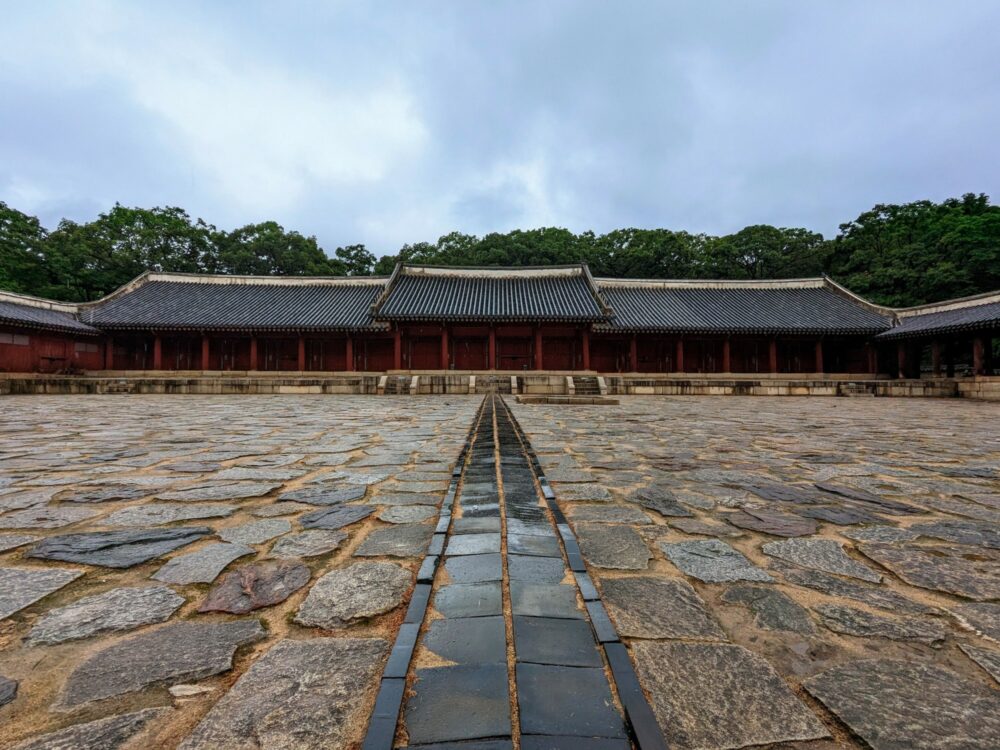
It’s about a 20-minute stroll from the southern end of Insadong Street to the market, a walk that takes you right past Jongmyo Shrine. Entry is included in the multi ticket for the royal palaces if you bought one. Much smaller than the palaces you visited yesterday, there’s scaffolding around the shrine itself at the moment, so it’s not anywhere near as attractive as usual. I was fortunate enough to visit just before it got covered up!
Still, the grounds are lovely to wander around, and since it only takes about half an hour to check out the main sights, it’s worth the small amount of effort. If you didn’t buy the multi-pass, entry is ₩1000. Note that while you can walk around by yourself at the weekend like we did, you’ll need to join a (free) tour to visit the shrine during the week.
From the tranquillity of Jongmyo to the mayhem of Gwangjang market, the difference couldn’t be more extreme. The market is seriously busy at weekends: we got there at around 2:30pm on a Sunday afternoon, and as you can see, even moving around was difficult! Early or late on a weekday would be a much better option if you’re not a fan of crowds, although note that most stalls are closed on Mondays.
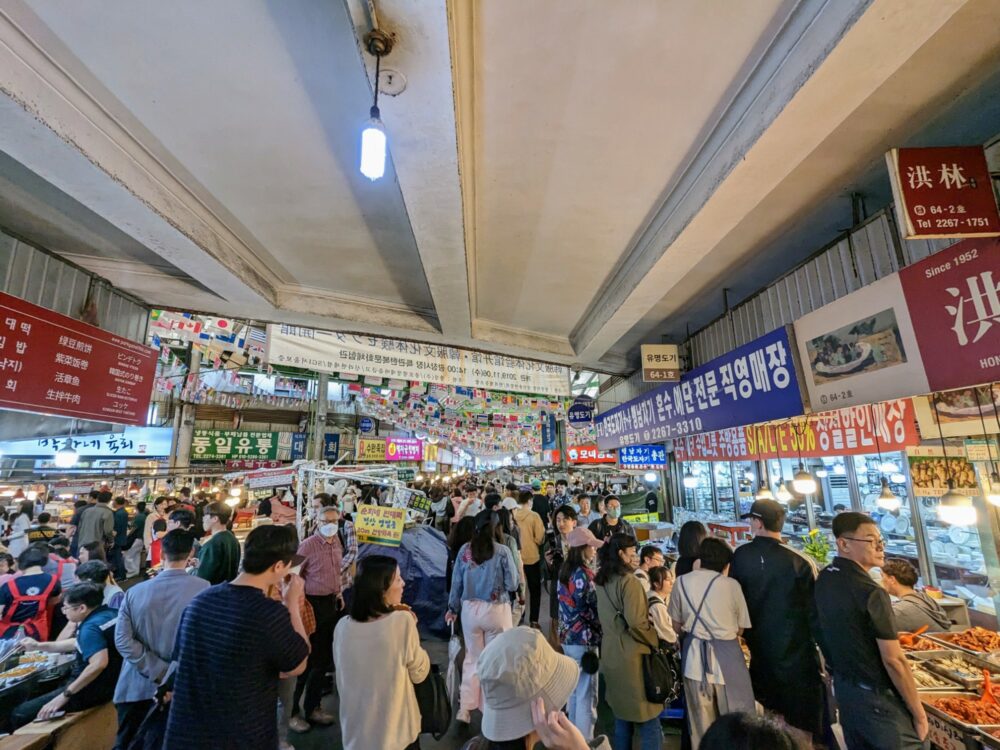
If you’re hoping to visit Cho Yonsoon’s noodle stall, keep an eye out for the Netflix signs in the middle of the market, near where the two “lanes” form a crossroads. The line was extremely long when we visited, so we skipped out on that experience, but there was an endless supply of other great food stalls to choose from.
I particularly enjoyed the mung bean pancakes, hot and delicious straight from the deep fryer: several vendors offer them. Many other local dishes are available as well, most from multiple stands in the market: just be prepared to wait for a seat during busy periods if it’s not something you can order to go.
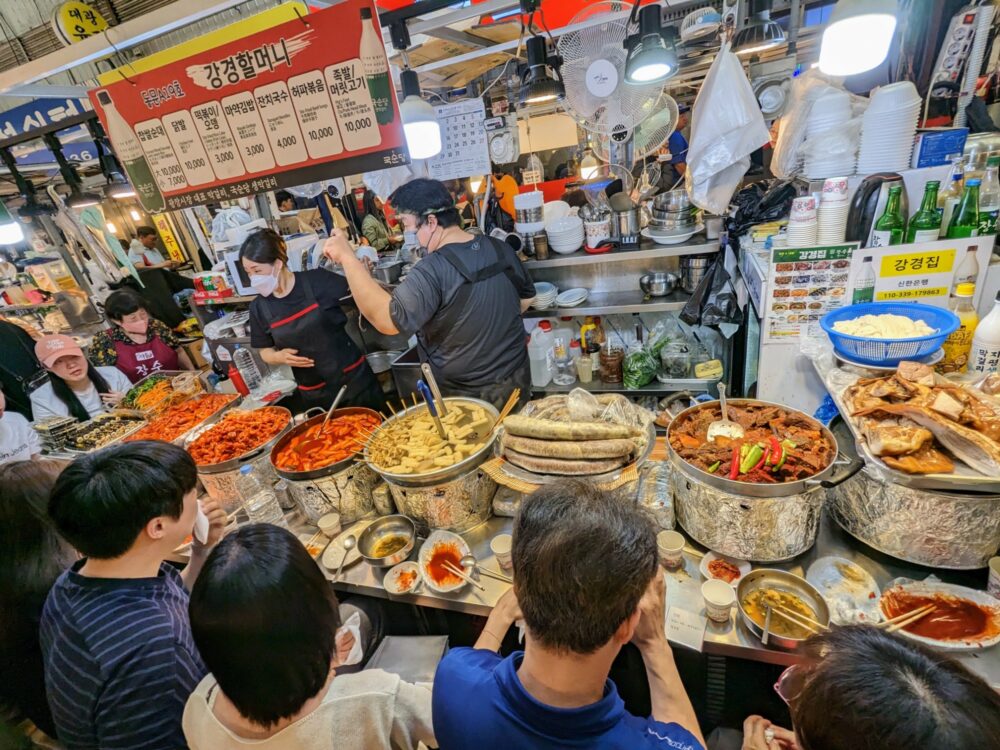
How long you spend in the market will likely depend on your appetite for both food and large groups of people. Give yourself half an hour if you only walk through from one end to the other and grab something to snack on while you’re strolling, and at least twice as long if you plan to sit down at one or more popular spots.
When you’re done, leave via the southern exit from the market and head for Euljiro 4(sa)ga metro station: it’s on the same line as the Hongik University stop for Hongdae.
Day 7: Gangnam Style
I try to blot out a lot of music from the early 2010s, but try as I might, Gangnam Style is an earworm that I just can’t get rid of. That song (and damn horse dance) was everywhere a decade or so ago, and its commentary on the lifestyles of the rich and famous introduced the rest of the world to both K-Pop and Seoul’s most high-end neighborhood. Today, you’re off to Gangnam.
Your first stop is Starfield COEX Mall, a vast shopping and exhibition center that’s full of everything from fast and high-end fashion to a large food court and a multistorey library that you’ve almost certainly seen on Instagram.
Getting there from Hongdae is easy: just jump on line 2 of the metro heading counter-clockwise (the “outer circle”) to Dangsan station, then switch to line nine until you get to Bongeunsa station. It takes about 35 minutes in total: leave the station via exit 7, which leads directly into the mall.
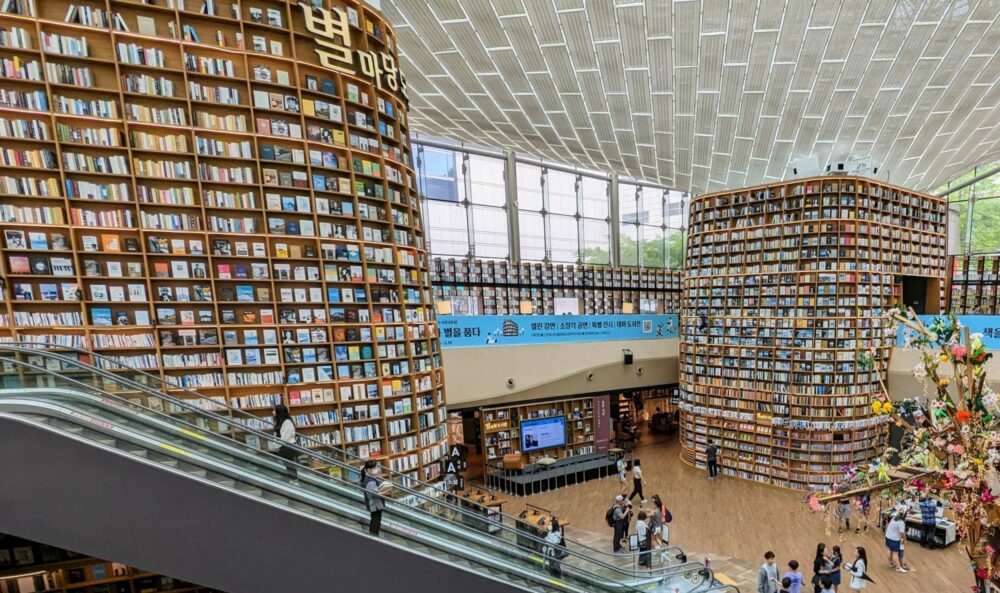
The most famous part of the mall, at least these days, is the Starfield Library that I mentioned earlier. With multistorey bookcases holding thousands of books and stretching from floor to ceiling, it’s hardly surprising that this is a popular spot with Instagrammers and Tiktokers. There isn’t a time where you’ll have the place to yourself, but going early on a weekday means that at least the visitors won’t outnumber the books.
While it’s predominantly a library (you’re welcome to take a book from a shelf to read at one of the nearby tables or sitting on the steps), there are also several tables with titles to browse and buy as well. They’re mostly in Korean, but many of the coffee-table books would make for great souvenirs even if you don’t speak the language.
Once you’re finished up there, it’s time to explore the rest of the mall. Honestly, you could spend all day inside if you wanted to: with something like 300 retail, food, and drink outlets, I suspect most visitors will run out of time before they run out of ways to spend their money.
There’s also a large aquarium attached to the mall, with around 20,000 sea creatures inside including sharks, rays, turtles, and many more. It’s a great spot to take the kids, but is worthwhile for adults as well, especially if you’ve never been to a large aquarium before. Give yourself around 60-90 minutes to look around: it’s worth booking online to save money on the walk-up price.
If all that shopping and sea life-spotting leaves you in need of sustenance, head downstairs to the sprawling food court, which has what feels like an endless range of local and foreign restaurants. I wandered around for at least fifteen minutes before finally settling on a tasty bowl of samgyeopsal from a small stand.
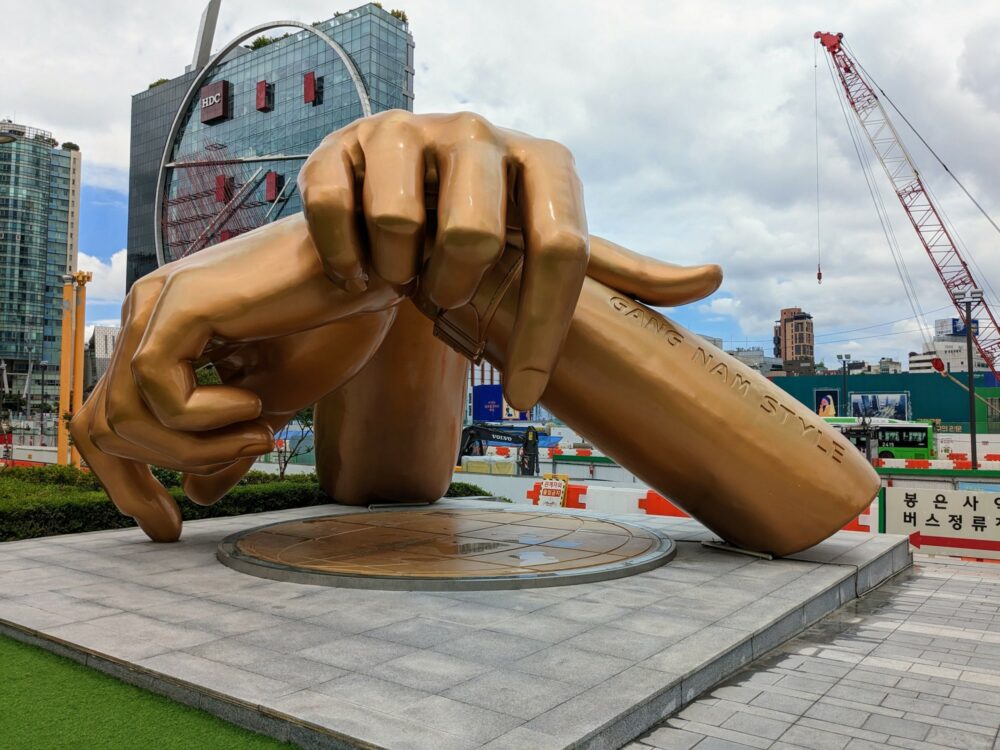
Just in case you’d forgotten where you were after the sensory overload of being inside a huge shopping center, you’ll be quickly reminded as soon as you leave. After the worldwide success of that song, it was deemed only appropriate to put up a huge sculpture of Psy’s folded hands outside COEX, complete with “Gang Nam Style” engraved on one of the forearms.
The fun doesn’t stop there, mind you: there’s a large area of (fake) grass alongside, with a video terminal that loudly plays Gangnam Style on demand so that you can dance along to your heart’s content. That’s not a hypothetical, by the way: I’d be surprised if you didn’t see someone performing in front of the statue when you’re there.
Once you’re done, it’s finally time to leave the mall precinct, but you’re not going far. Just over the road lies Bongeunsa, a Buddhist temple complex that’s a peaceful contrast to the shrine to consumerism that you’ve just left. It dates back to 794, although it now sits about a kilometre up the road from its original location, and most of the buildings are reconstructions after fire and war destroyed much of the complex in the middle of last century. Entry is free.
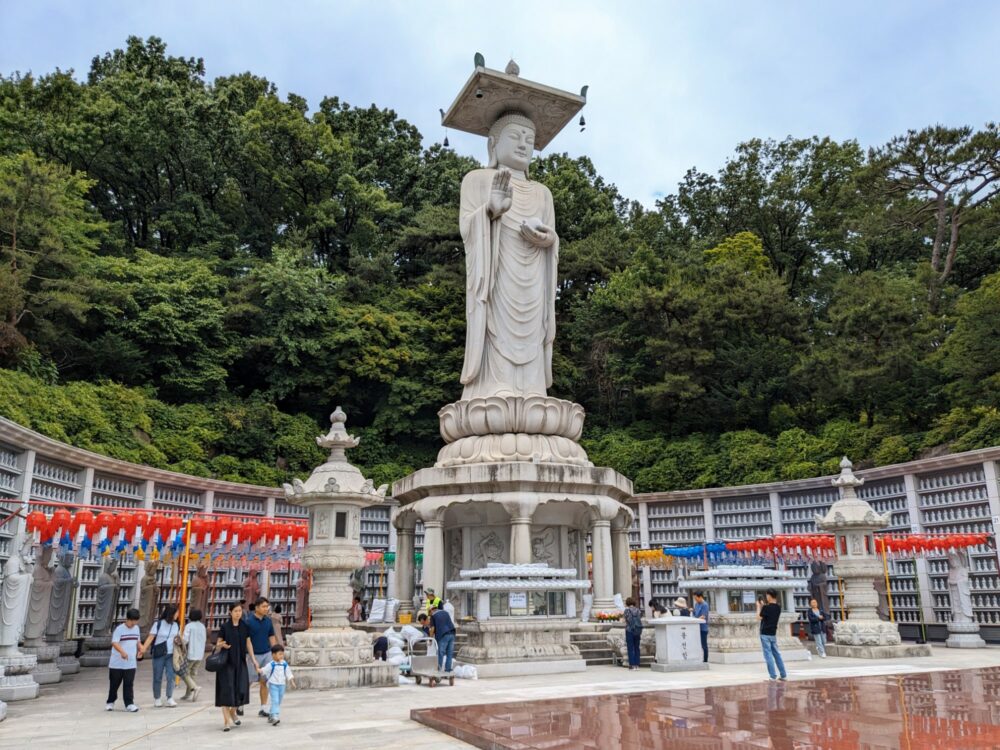
The highlight is definitely the huge stone Buddha that stands over 20m high, towards the rear of the temple complex. Be sure to check out the alcoves surrounding the statue as well: each one has dozens of small statuettes inside.
It’s not a huge area, but the wooded hillside is lovely to walk around for half an hour or so. A ceremony is held at 6:40pm each evening where monks beat drums and bang gongs for several minutes: it’s worth sticking around for if you’re visiting at that time. There’s a morning version of the ceremony as well, but since it happens just after 4am, it’s a touch less likely that you’ll be there for it!
If you happen to be there on a Thursday afternoon, it’s also worth jumping on one of the temple experiences that starts at 2pm. Costing ₩10,000 and lasting around two hours, it includes a tour, guided meditation, and a tea ceremony and conversation with temple monks.
After you’re finished at the temple, it’s time to make a choice. If it’s getting late in the day and you’re done with sightseeing, feel free to head back to your hotel: assuming you’re staying in Hongdae, I’ve got a delicious dinner recommendation for you below. If you’ve got the time, though, there’s plenty more to see and do in Gangnam, including:
- strolling along Apgujeong Rodeo Street and Cheongdam Fashion Street, where it’s easy to see the high-end style that the area is known for. If you’ve got a sudden hankering for an Armani suit or Gucci handbag, this is the place to get it.
- enjoying the colourful gingko trees (in autumn) on Garosu-gil, another popular shopping street with cute little boutiques and more mainstream brands, including a particularly large Apple store.
- getting your K-Pop on on K Star Road, where large, brightly-coloured bear statues line a roughly 1km stretch of footpath. The main attractions are the (shock) Psy and BTS bears, but there are many others.
- heading up to the top of Seoul Sky at Lotte World Tower (the highest building in Korea) for great views over the city skyline. Again, it’s cheaper to buy the tickets in advance than in person on the day.
Dinner: Back in Hongdae, head for a dinner at Shin Migyeong Hongdae Dakgalbi. If you’ve never had dakgalbi before, you’re in for a treat: it’s basically a spicy chicken stir-fry, but that simple description doesn’t come close to describing just how delicious and fun this meal is.
After making a few simple menu choices (including the sides and how much chili goes into the food), the meal is cooked out the back, then tipped onto a large, heated cast-iron pan at your table to make sure it stays hot. Portion sizes are huge (we got one between two) and take a while to get through, which gives the perfect excuse to work your way through a bottle of makgeolli as you go.
It’s a super-fun, social kind of place, and while it isn’t huge, the tables turn over reasonably quickly, so you shouldn’t have to wait long for a table. We went around 6:00pm on a Monday and were seated straight away. It’s an inexpensive, super-tasty way to finish the day!
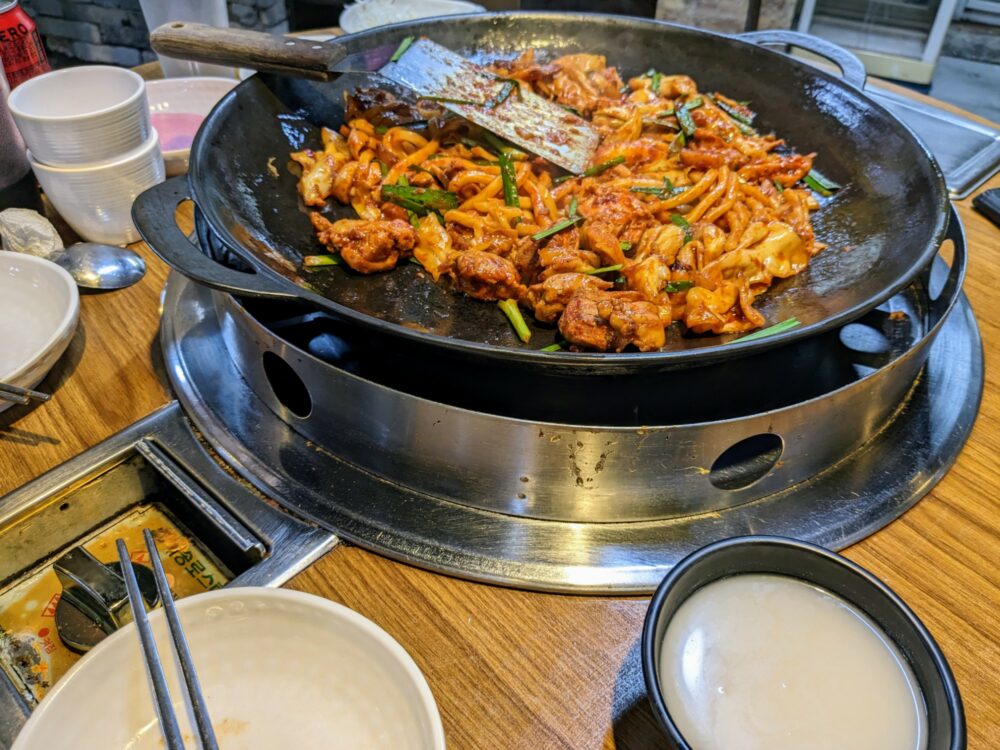
Day 8 and 9: Stunning Seoraksan National Park
You wouldn’t really know it when you’re in the middle of a huge city like Seoul, but South Korea is a seriously mountainous place: over 60% of the landmass is made up of hills and mountains. Hiking is practically the national pastime, and there are some stunning parts of the country to do it in.
For the next couple of days, you’ll be in one of the very best of those: Seoraksan National Park. I was honestly blown away by how beautiful this park was, and how good the trails were: in a couple of hours you can get to the tops of rocky mountain peaks, wander alongside beautiful tranquil streams, and stroll past delightful tumbling waterfalls. It was the highlight of my entire time in South Korea!
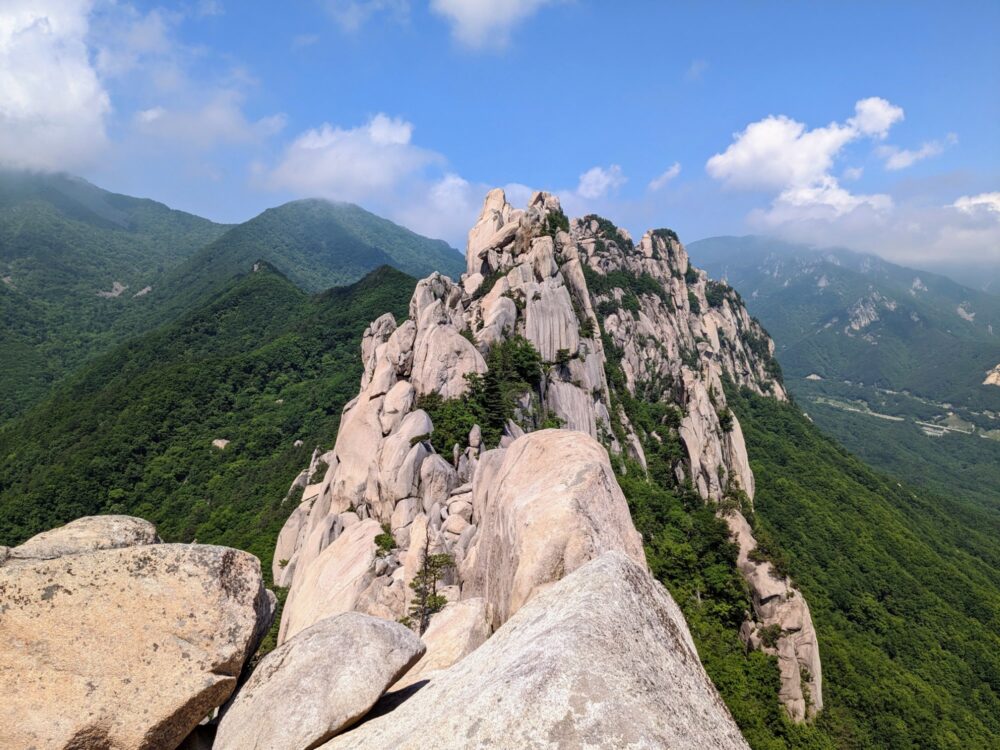
There are a few different ways to get there: I’ve written a detailed guide on how to get to Seoraksan, so feel free to read that for all of the info you need. To summarise, though, the easiest option for most people is to take a bus from Seoul Express Station to Sokcho, and then a local bus or taxi to the national park.
I’d suggest leaving Seoul reasonably early in the morning, since it takes about 2.5 hours to get to Sokcho, and another half-hour from there to the park.
You can buy the intercity bus ticket online ahead of time if you want certainty about when you’re going to leave, or just wing it and buy a ticket on the next available service when you get to the station. If that’s what you decide to do, you should be able to get a seat on a bus leaving within an hour or so, as long as you’re travelling outside weekends and peak fall colours season in September/October.
From the terminal in Sokcho, cross the street and wait for a number 7 or 7-1 local bus heading to the park entrance. You can use your T-Money card on this bus, or pay the fare in cash.
And now the fun part: all of the beautiful walks and viewpoints!
I have a complete guide to visiting Seoraksan National Park, which covers off all of the different walks worth doing, where to eat and drink, details of the cable car that goes up to Gwongeumseong Peak, and pretty much anything else I could think of. You’ll want to bookmark it before you go!
With around a day and a half in the park, you’ve got enough time to hike all of the shorter trails without being completely exhausted. Some of them are pretty flat and easy, others are definitely not. I’ve summarised the best ones below, but one of the key things to bear in mind when deciding which walk to tackle is what the weather’s doing.
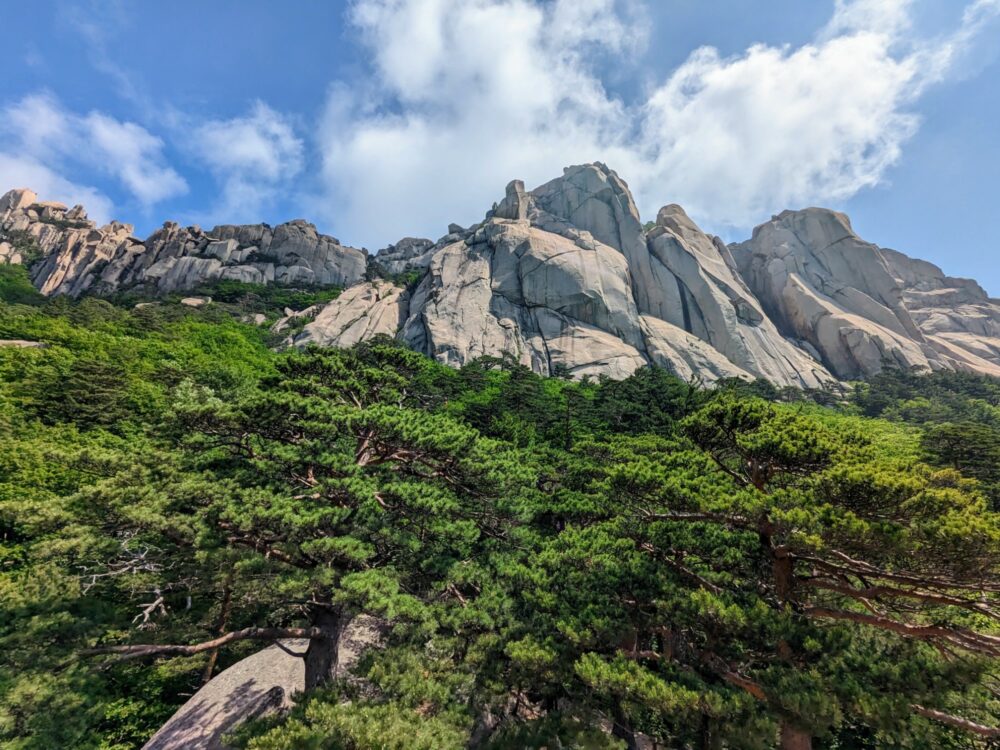
The weather in Seoraksan can be quite variable and change quickly: as a rule, I’d suggest doing the lower walks if it’s cloudy, and hope that conditions clear in time to tackle the higher trails. There’s not much point climbing all the way up to a viewpoint if you can’t see anything from the top!
Note that as of last year there are no longer any fees to enter the park, which makes it even more appealing to visit! Things like the cable car and onsite parking still cost money, though.
The Cable Car
While the highlight of Seoraksan National Park is its hiking trails, you don’t have to walk to get great views. A cable car climbs 700m from close to the park entrance up to the top of Gwongeumseong Peak, giving you most of the views with none of the sweat.
It’s believed there was once a fortress at the top of the hill, but there’s nothing left of it now: the reason to head up there these days is for the vista, not wandering around castle ruins.
If you’re taking the cable car, note that your ticket is for a specific time, and can only be bought in-person on the day. There are no advance tickets, mostly because strong winds often cause the cars to stop running at short notice.
Because the park gets busier as the day wears on, you’re best to head straight to the cable car office when you arrive, and buy the next available ticket that suits your plans. Cars leave every five minutes and hold 50 people at once: despite that, they often sell out completely at peak times.
If you buy a ticket for a few hours later and want to hike one of the trails beforehand, use the estimates in the section below to make sure you’ve got enough time. Likewise, if you can’t get on the cable car at all on the day you arrive, head back first thing the following morning and get a ticket for later that day instead.
Return ticket prices are as follows:
- Adults and teenagers: ₩15,000
- Children aged 3+: ₩11,000
- Infants under 3: Free
The car takes about five minutes to get to the top, where there’s a cafe, toilets, and viewing area. A path to the right leads uphill for 15 minutes to the “fortress” site, which is basically just a big, flat-ish rocky peak. Give yourself about half an hour to look around and take photos in all directions before heading back.
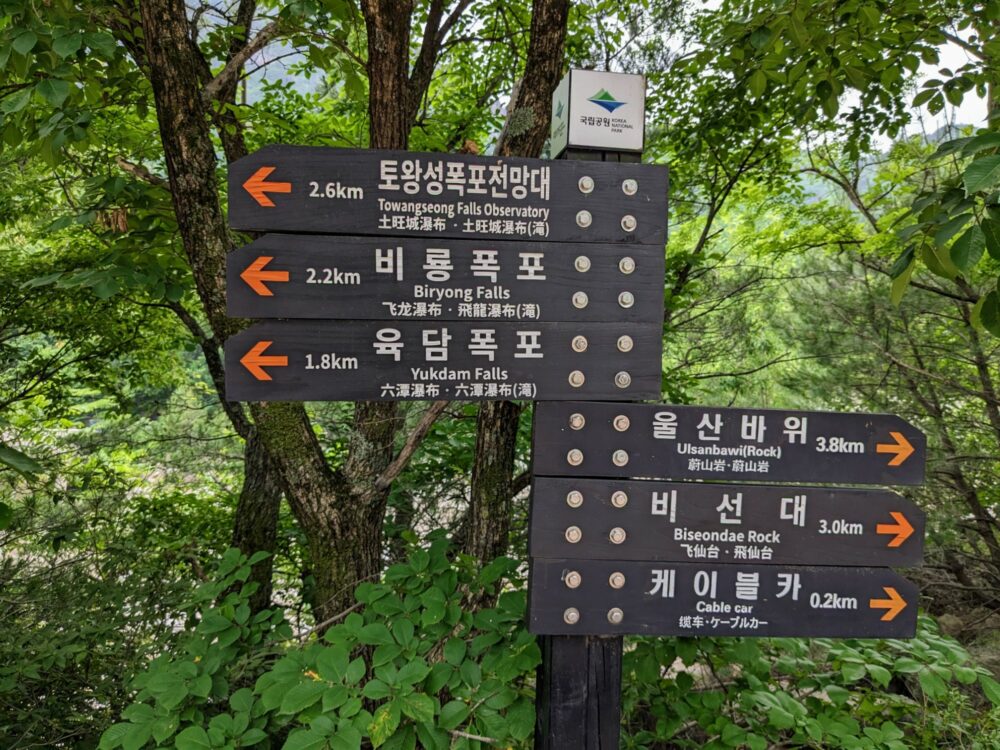
Walking Trails
These are the three trails I consider the best short-ish walks in the park. Ranging from roughly one to four hours in length, there’s something here for people of all fitness and mobility levels. Again, there’s much more detail in my full Seoraksan guide: the below is just a summary to whet your appetite!
Ulsanbawi Rock Trail: 7.6km return / 3-4 hours / Hard
Probably the biggest attraction in the park, the hike to Ulsanbawi Rock is glorious on a clear day. Along with spectacular views over the valley, you get to admire Ulsanbawi Rock itself, a distinctive jagged granite ridge that sits around 870m (2860ft) above sea level.
The first part beside the river is easy, with a concrete path to walk on and minimal climbing to do. The concrete ends once you hit the first set of stone steps, but even this section as far as Gyejoam Temple isn’t too difficult.
From there, the trail continues upwards, past a large boulder that’s worth clambering up on to for a great view of Ulsanbawi. It’s less than a kilometre from the boulder to the top, but it’s hard work: essentially one long staircase, with many hundreds of steps and no real shade once you’re above the tree line.
All that effort feels worthwhile once you get to the top, though!
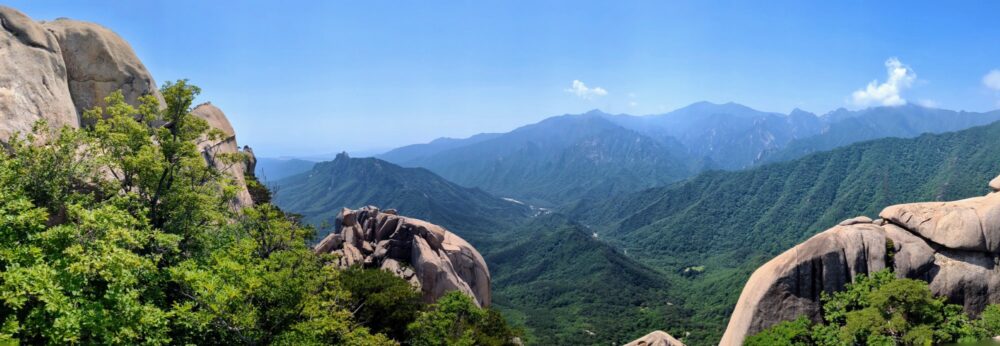
There are a few different viewing areas at the end, with different perspectives of the park and nearby countryside. Take a lunch break here, or at least have a drink and a snack: you’ve earned the rest!
While the return trip is faster and not as much of a cardio workout, it’s tough on the knees after a while. Let’s just say I was happy to see the end of the steps and get back to some flat ground again at the bottom!
Biryong Falls Trail: 4.8km return / 1-1.5 hours / Moderate
Fan of waterfalls? Look no further than the Biryong Falls trail. It’s a relatively short hike that starts out as an easy, flat nature trail through the forest, before climbing steadily alongside the river to two different waterfalls. If you don’t mind a workout, you can also extending the walk up a steep staircase to an observation platform for Towangseong Falls, the tallest in the country at 320m (1050ft).
After a gentle stroll through woodland, the path becomes steeper and rockier as it approaches Yukdam Falls. You get some lovely views as you approach and cross the suspension bridge over the falls.
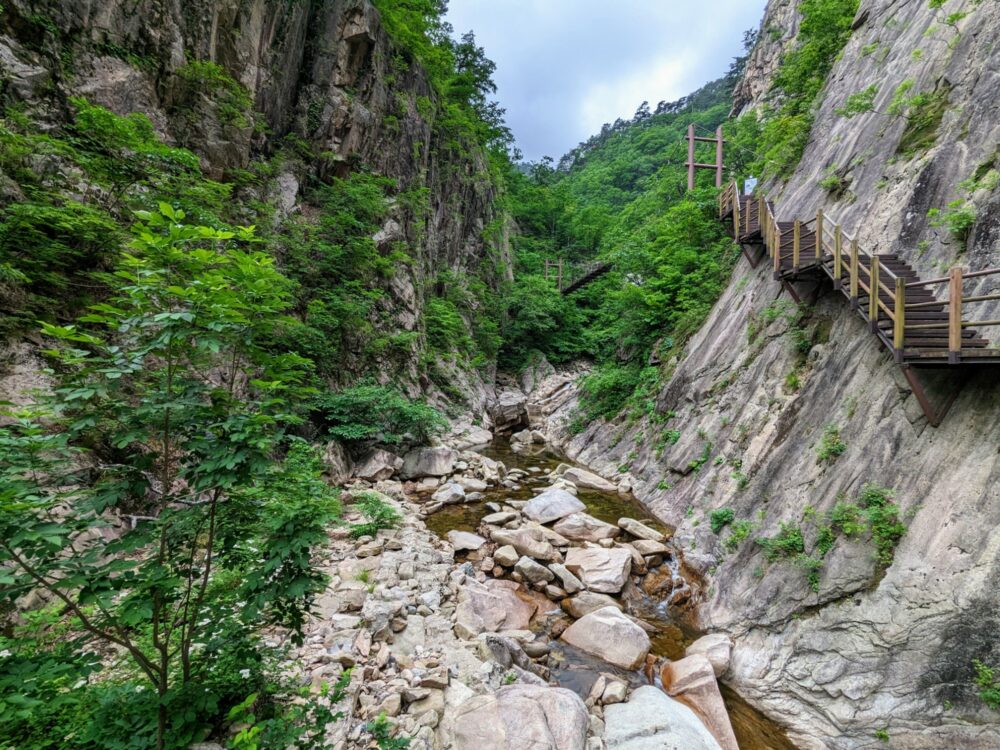
The next section is a bit steeper than the last, but still pretty straightforward as you climb up to Biryong Falls. It’s not the biggest or most exciting waterfall in the world, but it’s a good place for a snack or a drink, with plenty of seating around the pool at the base of the waterfall.
Many people turn around at this point, returning the way they came back towards the main part of the park. If you’re feeling fit, however, follow the sign pointing up to Towangseong Falls Observatory instead. It’s only an extra 400m, but you’ll feel every single one of them: it’s stairs, stairs, and more stairs the entire way.
Expect to take 15-20 minutes to get up there, and to be more than a little short of breath when you do. Once the panting subsides, you’ll find yourself on a multi-level observation deck, looking out towards a pretty significant mountain range and the tumbling Towangseong Falls in the distance.
You probably won’t spend too long up there, no more than five or ten minutes, before starting the journey down the stairs and along the main path back to where you started.
Biseondae Rock Trail: 6km return / 1.5-2 hours / Easy
The Biseondae Rock trail was the last hike I did during my time in Seoraksan, and one of the best. It’s the easiest of the three walks I mention here: you simply follow a stream up a valley the whole way, under tree cover and mostly on flat paths. It’s all very straightforward.
The trail is quite scenic on the way to the large rock that gives the path its name, but it’s when things open up right at the end that it gets seriously pretty. I was lucky enough to have the place to myself, and it was super-peaceful, with just the sound of buzzing insects and rushing water for company.
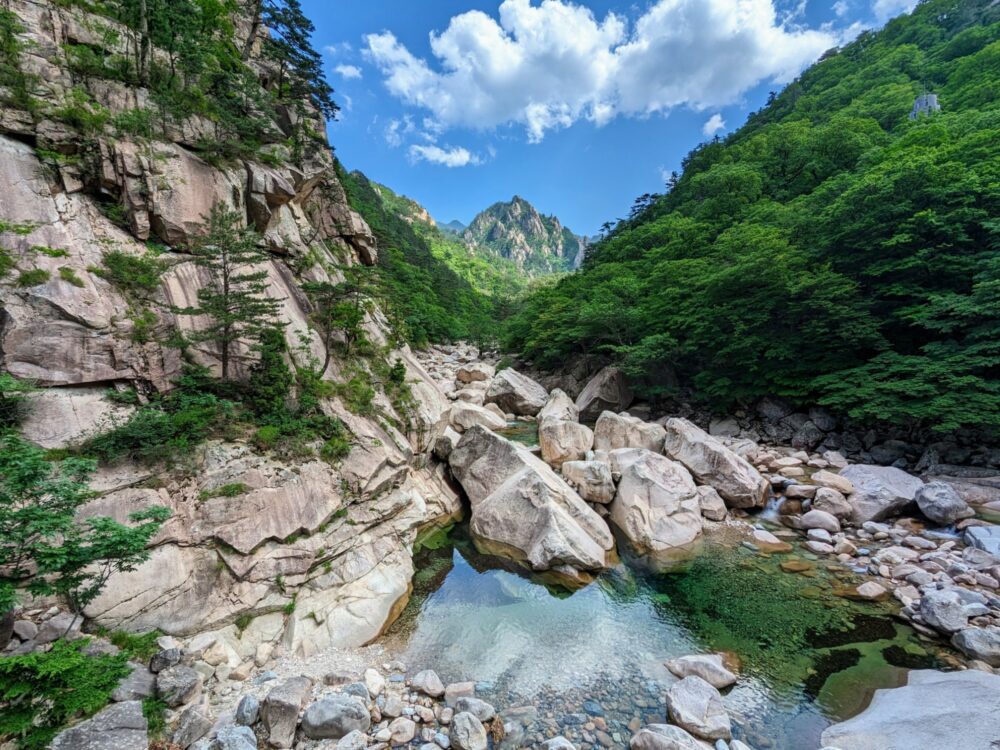
To find myself in such lovely scenery after less than an hour of easy walking made me very happy, and I lingered for a while before finally heading back to the start. It was the perfect trail to end my time in the park, after giving my calves and knees a major workout the rest of the time!
In terms of what you get out of it for what you put into it, I’d probably have to put this trail at the top of my list. Sure, the views from the top of Ulsanbawi Peak are far more dramatic and expansive, but they take a lot more effort to get to as well.
Where to stay for Seoraksan National Park: You’ve got two choices about which area to stay in for Seoraksan National Park: Sokcho, which is the nearest city a half-hour bus ride away, or somewhere along the road that leads into the park.
We opted for the latter, staying at a great family-run guesthouse about 3km (five minutes on the bus) from the park entrance. It was the best-rated place in the area and lived up to its reputation: with friendly owners, comfortable rooms, a simple but tasty breakfast, and reasonable prices, we were very happy with our decision.
Staying in Sokcho gives a much wider range of accommodation and food options; it just means a half-hour ride to and from the park each day. Next time I’d probably stay there to mix things up, most likely at Urbanstay Sockho Beach. It has clean, modern rooms, and is only a five minute walk from the bus terminal. It’s also very close to the beach, with great views over the water, and plenty of restaurants within easy walking distance.
Day 10: The Food and Shopping Mecca of Myeongdong
With your time in Korea drawing towards a close, it’s time to head back to Seoul. Check out of your accommodation after breakfast and head back to the bus station in Sokcho to retrace your steps from a couple of days ago. Again, if you’re travelling on a weekday outside peak times, you can probably just buy a ticket on the next service when you get to the station. At other times, book it in advance.
Note that I’m assuming your flight out of Korea is from Incheon or Gimpo airports in Seoul: if it’s one of the few that leave from Busan instead, there are a couple of direct buses per day that run there from Sokcho instead.
This time around, I’d suggest staying in Myeongdong. It’s one of the most popular restaurant and shopping areas in the city, has a huge street food market that springs into life each evening, and is convenient for getting to the airport the next day. What’s not to like?
This is definitely one part of town that’s set up for aimless wandering. Myeongdong’s main walking street has so much going on that I was very glad I didn’t have to keep an eye out for cars: there were far too many other interesting things to look at! Restaurants, bars, tiny boutiques and huge department stores, it’s a busy, bustling, neon-lit temple to the gods of retail.
If you’re looking for a temple of a different kind, the oldest Catholic cathedral in South Korea is also in Myeongdong, on top of a small hill a short but steep walk from the eastern end of the walking street. Be sure to visit the crypt and museum while you’re there; both are small but interesting.
If you’re on the hunt for Korean skincare products, you’ve come to the right place. Dozens of stores in Myeongdong specialise in them, including flagship outlets of major brands like Olive Young and Laneige. If you need a second suitcase just to carry all your new products home with you, never fear: there are plenty of luggage stores nearby as well!
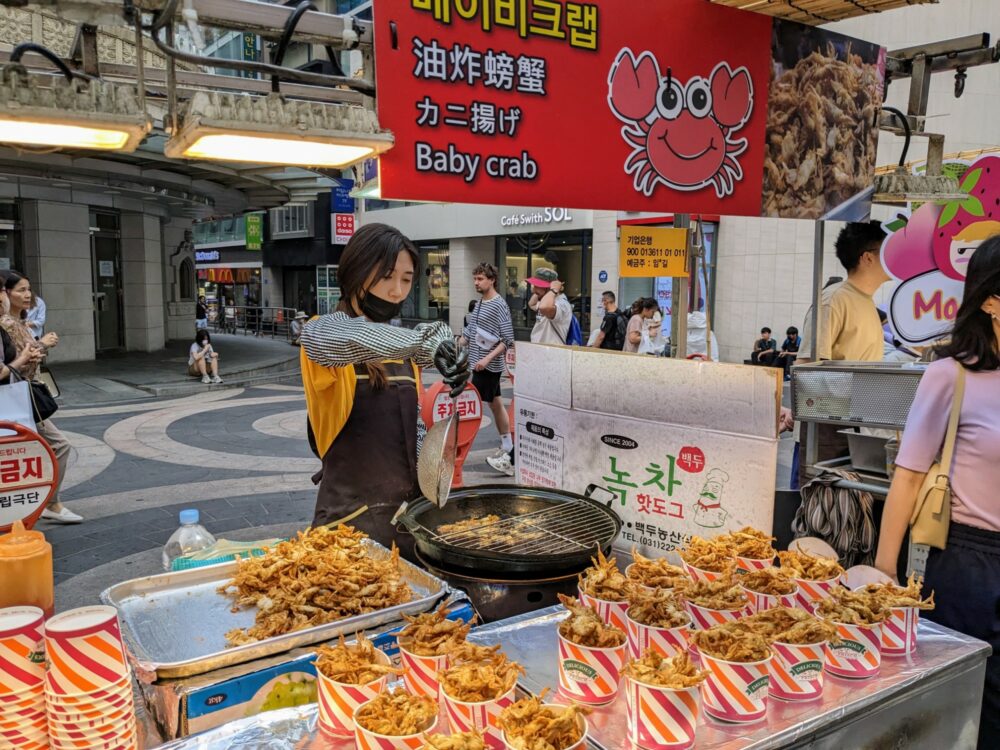
Street vendors start setting up the night food market along the walking street and surrounding roads from mid-afternoon: there are usually around 200 vendors on any given day, most dedicated to cooking up all kinds of delicious street food, but with many selling souvenirs and other random bits and pieces as well. The souvenirs weren’t anything you can’t find elsewhere in the city, but the street food stalls were a delight.
Definitely start out with an empty stomach, so you can try as many of the different options as possible. I particularly enjoyed the deep-fried crab and a few of the different beef and chicken skewers, but just wander around and see what grabs you (or what has the longest line). We spent well over an hour just strolling past the different vendors, choosing random things as we went. Most of the dishes are snack-sized rather than being a full meal, so they’re ideal for grazing.
Now that you’re full of delicious street food, it’s time for a short walk to work some of it off. As you’ve been exploring Seoul, you’ve probably noticed a large hill that’s visible from Myeongdong and much of the busy downtown area, complete with a prominent broadcast tower at the top. That’s Namsan Hill and N Seoul Tower, the latter of which sits around 500m (1650ft) above sea level and has commanding sunset views over the city.
Getting to the top couldn’t be quicker or easier: a cable car zips between the base of the hill near Myeongdong and the tower in about three minutes. Once you get there, the four different levels have a range of restaurants, multimedia displays, and other attractions to check out beyond just the spectacular vista.
You can buy the cable car and tower entry tickets separately, but it’s cheaper and more convenient to just get them as a package instead. The lower cable car station is only a 10 minute walk from Myeongdong metro station.
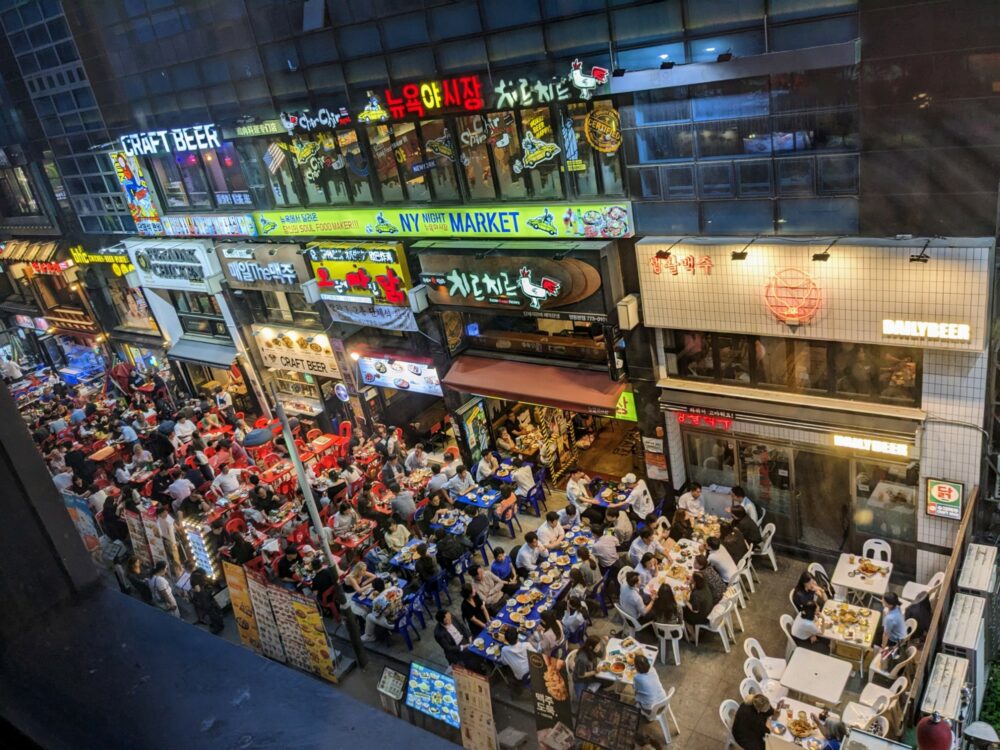
If you’ve worked up an appetite again by the time you get back, or at least a thirst, that chicken and beer street I mentioned earlier is well worth a visit. With so many restaurants crammed alongside each other, competition is fierce and quality is high, so you can’t really go too wrong with any of them. The hardest part will be finding somewhere with a spare table: it’s a popular spot as the night wears on!
Where to stay in Myeongdong: We stayed at a delightful cinema-themed hotel right in the heart of Myeongdong, and only a block or two from the night market. Our room was stylish and spacious, with a great bathtub, and the staff were lovely: we even got a free bag of popcorn when we arrived!
There was no problem with storing our bags when we arrived before check-in time, either. The hotel sits alongside a busy strip of chicken and beer restaurants, which is very convenient when you’re hungry!
Final Day
Sadly it’s arrived: your final day in South Korea! If you’ve got an early flight, then all you have left to do is take the metro to the airport. Luckily that’s very easy to do, since Myeongdong is on the airport line. It takes about 75 minutes to get there.
If you’ve got a few hours to spare, though, there are plenty of ways to spend your time beyond just sitting in your hotel room! I’ve included a couple of specific suggestions below that are easily accessible from Myeongdong; if your flight isn’t until sometime after dinner, you could also do any of the longer activities I suggest in the next section instead. The place we stayed at was more than happy to look after our bags all day if needed!
Take in the Tranquility of Cheonggyecheon Stream
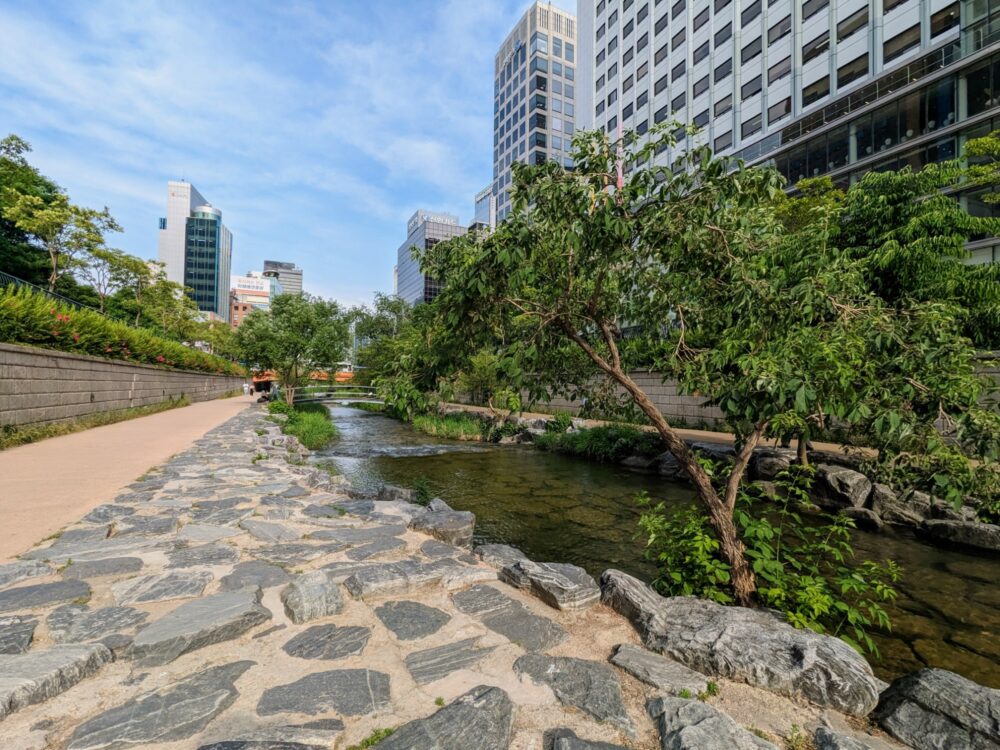
If you want to see an example of urban revitalisation done right, you need to look no further than Cheonggyecheon Stream. The highways that once covered this little waterway were ripped up in 2005, and a once-ugly thoroughfare was turned into a lovely place to stroll and relax.
Sunk below street level, the 8km (5 mile) path is surprisingly peaceful, with plenty of places to sit and relax. We spent a wonderful hour or so walking the first half, from the entrance near Gwanghwamun station in the west to Dongdaemun. The first section is definitely the busiest: after that, the surroundings start to become less manicured, with narrower paths and fewer people.
Just walk as far as you feel like: you can easily get back up to street level at any point if you only have a short amount of time, and then take the metro or a taxi back to collect your bags.
Relax in Seoul Forest
If even the tranquil surrounds of an urban stream aren’t relaxing enough for you, how does a vast park in the middle of the city sound? Seoul Forest is actually where the Cheonggyecheon Stream path ends, but if that’s where you’re headed, it’s easier to take the metro instead: line 4 goes directly there.
Across the five separate parks you’ll find everything from botanic gardens to playgrounds, restaurants, and even a stage where concerts are held during summer, but with close to half a million trees spread over 300 acres, there’s plenty of nature (and space) for everyone.
If you’re more interested in wildlife and woodland, the “Eco Forest” is the place to go. It’s home to a population of elk and deer in a series of enclosures, along with chipmunks and other smaller animals roaming free.
Extra Time
If you have an extra day or two in South Korea, never fear: I have a few more suggestions for how to spend them! As well as the three Seoul-based options I talk about below, you could easily add another day in Gyeongju so you can explore it at a more leisurely place, or work in a full day in Sokcho to chill out on the beach and explore the city. They’re all good options!
Optional: Day trip to the DMZ
Many first-time visitors to South Korea want to visit the DMZ, the infamous 4km (2.5 mile)-wide no-man’s-land that forms the border between South and North Korea. The two countries are still technically at war despite the 70-year armistice, and access to the area close to the border is heavily restricted. The only way to get there is on an organised tour, and numbers are limited even then.
In the past, I would have included a DMZ tour as an absolute must-do, but for now at least, it’s only optional as far as I’m concerned. Why? Well, mostly because the Joint Security Area (JSA)—the famous blue barracks where North and South Korean soldiers stand face-to-face—is currently out of bounds. Since the pandemic, tours to the JSA have been on and (mostly) off, and as I’m writing this now, there simply isn’t a way to get there.
As a result, the closest you’ll get to North Korea is standing on a hill and looking into the country from afar with binoculars. The upside is that these trips are much cheaper than the JSA tours when they’re running, the downside is that it’s probably not really the DMZ experience that you were envisaging.
Even these non-JSA tours are very popular, mind you, so if you are thinking about going, don’t leave it until the last minute to decide. It’s not uncommon for spots to be sold out a week or more in advance during busy periods.
On these tours, you typically get to visit one of the “infiltration” tunnels dug by North Korea in a failed attempt to set up a surprise attack, along with the DMZ observatory point and freedom bridge. It’s still an interesting and thought-provoking trip; just be aware of what it does and doesn’t contain in 2024!
Optional: Day spent hiking in Bukhansan
While Seoraksan National Park offers wonderful trails and incredible scenery, and is absolutely worth the visit, it does take a bit of time and effort to get there from Seoul. There are no such concerns with Bukhansan National Park, though: you can literally take the metro there from downtown Seoul!
Named after the three-peaked Bukhan mountain that forms the centrepiece of the park, it takes under an hour to get there from pretty much anywhere you’re likely to be in Seoul. There are three entrances, each of which is accessible by public transport, but the easiest is probably the eastern gate. Be sure to visit the (Jeongneung) visitor information centre just inside it when you arrive.
That’s for two reasons: to get trail maps and general information about the walks on offer, and also to find out which paths are currently closed. All of the popular trails (which given the proximity to Seoul, is basically all of them) are closed on a rotating basis to help protect them from overuse. Make sure the trail(s) you plan to walk are open on that particular day!
I’ve included a couple of good trail options below to get you started, but there are many others. The Alltrails app has them all marked out, or as I say, pick up paper maps from the visitor centre before you start. Admission to the park, fortress, and temples are all free.
- Obong Course: this 7.6km loop trail is moderately difficult but worth the effort, winding past Dobongsan mountain with great views on its way to the lovely Songchu falls. It takes 2-3 hours.
- Baegundae Peak: this is a challenging one-way trail that runs east-west across the park and climbs to its highest point, at 835m (2744ft). It gets trickier towards the top, with metal cables set into the rocks to help pull yourself up. Don’t tackle it unprepared, but if you’re capable, expect stunning views from the top. It takes 4-5 hours to complete.
Optional: Visit to Lotte World
For an adventure of a completely different kind, head to the sprawling expanse of Lotte World. This enormous indoor theme park in Sincheon is the largest of its kind in the world, covering four stories and covered by a vast glass dome. There’s also an outdoor section, dubbed Magic Island: a man-made island that sits in middle of Seokchon Lake that contains most of the rides, along with cinemas, restaurants, and more.
It’s hard to even summarise everything on offer here at South Korea’s version of Disneyland: from the amusement park and ice-skating rink to a museum, department store, aquarium, shooting range, roller coaster, huge spinning gyro swing, laser and music shows, VR roller coasters and arcade games, and who knows what else, there’s more than enough to keep adults and kids alike amused for the entire day.
There’s even a monorail that whisks you around the complex, which I think gives some idea of the scale of what’s on offer here. To get there, jump on the metro and head for Jamsil station (exit 4). As is often the case in Korea, it’s cheaper to buy tickets in advance than to show up and buy them on the day.
Summary and Checklist
Given how long this itinerary ended up being, I figured it’d be worth putting together a checklist of all things that you’ll want to do in advance of your trip, just to have them together in one place. I hope it’s useful!
Further Reading
- Tech Guide to South Korea for all the little (and not so little) differences about things like making payments, how taxis and T-Money work, why Google Maps is so bad in South Korea and what to do about it, plus the best ways of staying connected and whether a local phone number is as important as everyone says
- How to Get to Seoraksan National Park for the nitty-gritty about transport to and from the park
- Guide to Seoraksan National Park for trail information, where to eat and drink in the park, cable car details, other things to see and do, and so on
Buy
- a physical SIM or eSIM so you’re connected before leaving the airport. Note that the plastic card that contains the physical SIM also works as a T-Money card, so you don’t need to buy a separate one!
Book
- Accommodation:
- First night near Seoul Station (if necessary)
- Two nights in Gyeongju
- Five nights in Hongdae
- Two nights in Sokcho or Seoraksan
- Last night in Myeongdong
- Tours and tickets:
- High-speed train to and from Gyeongju
- Express bus to and from Sokcho
- Discounted entry tickets for the aquarium, N Seoul Tower, and Seoul Sky
- Tour of the Secret Garden at Changdeokgung Palace (no more than six days in advance)
- Optional: DMZ Tour, Lotte World tickets
Download
- Naver Maps – iOS | Android
- Kakao Maps – iOS | Android
- Papago – iOS | Android
- Uber/UT – iOS and Android
- Kakao T – iOS | Android
- XE – iOS | Android
- Airvisual – iOS | Android
And there we have it: my complete guide on how to spend 10 days (or more) in South Korea! I think I’ve covered everything you might need to know, but if you’ve got any questions, feel free to leave them in the comments and I’ll do my best to help. Most of all, enjoy your time in this delightful country!

